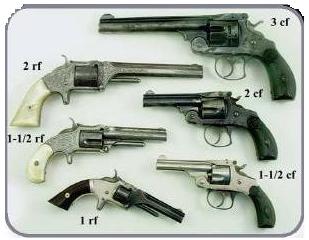
Section One
COLLECTING SMITH & WESSON:
SPECIAL CONCERNS AND TRICKS OF THE TRADE
Smith & Wesson may legitimately be characterized as the premier handgun manufacturer of the United States and the world. Its rich history and wide range of products make it a fascinating study for historians and a treasure trove for collectors. It was the first American maker of repeating handguns that fire self-contained metallic cartridges, and continues as the leader in the police, civilian, military, and sporting handgun market today.
Odds are good that any shooting sportsman or general gun enthusiast will have at least one Smith & Wesson around. It would be difficult to find a gun shop anywhere that didn’t have a few S&Ws in the handgun display case. Any time a double-action revolver or semi-auto pistol purchase is planned, it’s likely that a Smith & Wesson product will at least be considered.
Accordingly, we’ve tried to make a book that will be straightforward and useful to the general dealer or gun enthusiast, as well as contain a level of detail useful to the most advanced collector. We’ll start out by discussing a few concepts that you need to grasp in order to “speak S&W.” (Hint: Check out the “Illustrated Glossary” at the end of the book if you run into confusing terminology.)
FRAME SIZES OF REVOLVERS
S&W revolvers are often referred to by frame sizes. On the tip-ups and top-breaks, these are numbers. On Hand Ejectors, they are letters.

Frame sizes of Tip-up (rimfire: “rf”) and Top-break (centerfire: “cf”) revolvers.
TIP-BREAK TOP-BREAK
• Model 1 frame – smallest; 7-shot .22 tip-up only
• Model 1-1/2 frame – medium small; 5-shot .32 tip-up or top-break
• Model 2 frame – medium; 6-shot .32 tip-up or 5-shot .38 top-break
• Model 3 frame – large; 6-shot .44 top-break
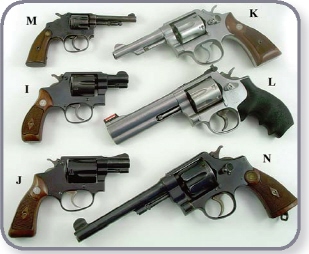
Frame sizes of Hand Ejectors.
HAND EJECTORS
• M frame – smallest; 7-shot old model Ladysmith only; no longer made.
• I frame – small; 6-shot .32 size; no longer made; has leaf mainspring, replaced by the improved I frame.
• Improved I frame – still a small frame but with a coil mainspring, Usually a 4 screw frame, replaced by the J frame.
• J frame – small; 5-shot .38 size; (6 in .32 caliber) current production; Chiefs Special sized. This frame was enlarged slightly in 1995 to accept the .357 Magnum round, and may be called the “J Magnum” frame. By 1997, all J-frame revolvers were produced on the J Magnum frame.
• K frame – medium; 6-shot .38 size; current production; .38 Military & Police size. Redesigned in 1999.
• L frame – medium-large; compromise between K and N size; current production, redesigned in 1999.
• N frame – large frame; 6-shot .44 size; current production; .44 Magnum size, redesigned in 1999.
• X frame – humongous frame with K-frame grip; recently introduced for the .500 Magnum.
Although the above “J, K, L, N” frame size terminology is generally used by collectors to designate both carbon steel and stainless steel revolver frame sizes, the S&W factory uses a separate set of letters to designate stainless steel frame sizes. In this system, a stainless J-sized frame is an E frame, a stainless K is an F, a stainless L is an H, and a stainless N frame is a G frame. For more information on factory frame designations, see the beginning of the “Numbered Model Revolver” section.
SCREWS: 3, 4, OR 5
S&W collectors often refer to Hand Ejector (HE) revolvers by the number of screws in the frame. From about 1905 to 1955 most Hand Ejectors had five screws – four sideplate screws and a screw in the front of the trigger guard. About 1955, the top sideplate screw was eliminated on most models, and these are referred to as four-screw guns. Around 1961, the trigger guard screw was eliminated, and all subsequent production is known as three-screw. When counting screws, remember that the rear sideplate screw is covered by some types of grips, and don’t overlook the trigger guard screw that enters from the front of the trigger guard. To confuse things further, the earliest Hand Ejectors, 1896 - 1905, had only four screws (pre-five-screw four-screws?), and some models had a sixth screw, a locking screw that held in place the top sideplate screw, found in early alloy frame revolvers.
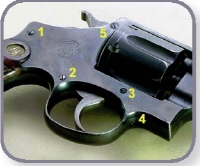
Screw count on Hand Ejector frame.
PINNED AND RECESSED

Pinned vs. non-pinned barrel.

Recessed vs. non-recessed cylinder.
This refers to Hand Ejectors made prior to about 1982. Prior to that time, all Hand Ejectors had the barrel fixed to the frame by a pin through the rear of the barrel and the frame and all magnum caliber revolvers had recessed chambers to enclose the rim of the cartridges. Rimfire .22 Long Rifle cylinders have been counterbored since 1935 and continue so to this day. When the Magnum centerfire caliber recessed cylinder was discontinued the overall length of the cylinder was changed to make up for the difference in rim thickness.
GENERATIONS OF SEMI-AUTOS
The centerfire metal frame traditional double action style semi-autos produced from 1954 to date are sometimes referred to by their generation:
First Generation: Made 1954 - 1982. Examples have two-digit model designations, most notably Model 39 and Model 59.
Second Generation: Made 1980 - 1988. Many improvements, some oriented to ensure reliable function with new styles of ammunition developed since introduction of first generation. Examples generally have three-digit model designations.
Third Generation: Made 1988 - date. Many improvements; most obvious on casual inspection are improved ergonomics of a more rounded comfortable grip. Examples usually have a four-digit model designation. (There are two notable exceptions – the “no-frills” variations of these models, which tend to have three digit model designations in the 900s; and the compact Chiefs Special versions of‚ these models which have model designations consisting of “CS” plus the caliber – i.e., “CS-40”.)
Note: Not all S&W semi-autos fit into the generation designations. Examples include the early .32 and .35 pocket semi-autos, .22 semi-autos, the polymer-framed Sigma series introduced in 1994, and the Walther design SW-99 introduced in 1999.
TYPE OF FINISH
As with all gun collectors, S&W enthusiasts invariably seek guns with original factory finish.
Generally, but not always, a blued top-break revolver will bring a bit more than a nickel gun in comparable condition. There are at least three reasons: First, for most of the 19th-century nickel was a more popular finish and in most, but not all, models was a more common finish than blue. Secondly, nickel finish is more durable than blue, so a higher proportion of surviving nickel guns will show more finish than their blued counterparts. Finally, a nickel gun that has lost a good portion of its finish can have a dark and bright mottled appearance that many collectors dislike, while a blue gun tends to have a more blended appearance to its color as it loses its finish.
As we move into the Hand Ejectors, single-shots, and semiautomatics, the situation tends to be reversed. In most, but not all, of the later models, blue was much more common than nickel and there was an additional charge for nickel plating.
Over the past two decades, stainless steel has become the overwhelming choice of revolver buyers, to the extent that some blued carbon steel models have been discontinued in favor of their stainless steel counterparts. On a S&W purchased for actual use, stainless models nearly always bring more than their blued or nickeled counterparts. Where a substantial premium is paid for a particular finish, we have tried to note it in the listing of the individual model.
Special finishes will generally bring a premium if factory original. Among tip-ups and top-breaks, silver or gold plating may occasionally be found. Among Hand Ejectors, two-tone nickel and blue finished guns, nicknamed “pintos,” could be special-ordered during certain eras.
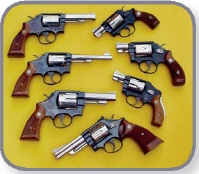
Examples of scarce special-order “Pinto” finish.
REFINISHED GUNS
Identifying a refinished gun is very much an inexact art, but can be vitally important when considering paying a hefty premium for an antique or rare variation gun that has a high percentage of original finish. Some things to look for include:
Markings should be crisp. Edges of letters should not show drag marks or blurring. Screw holes should not be dished.
Metal edges should be sharp, not rounded. You may find it easier to check this by running a finger across the edges rather than relying on your eyes.
Inspect the finish carefully for pits or scratches under the finish that were too deep to polish out during refinishing. S&W factory polishing was nearly always excellent, with no discernable scratches or dings left on the gun before the original finish was applied. Blemishes underneath the finish suggest a refinished gun. Don’t rush – spend some time with a magnifying glass.
Compare the color, luster, and polish of the finish to known original examples.
Get enough light. Outdoor sunlight is great, but not always practical. The very powerful pocket flashlights, such as those offered by Sure-Fire, are great for closely inspecting blued finish. Gun shows tend to be held in venues with notoriously poor lighting – “sellers’ light.” A flashlight can be a great help.
Does the finish show appropriate signs of aging? Older blued guns in particular tend to slowly turn “plum,” a flat purplish-brown color that seems to emerge from underneath the brighter factory bluing. Under very strong light, this will often be discernable on old original blued guns, while more recently reblued guns may tend to show a more solid blue, with less depth. Nickel finishes, on the other hand, occasionally will turn milky. Although generally bright original nickel finish would be preferred to milky nickel, the milky effect is reportedly difficult to duplicate with artificial aging methods, and may lend some assurance that the plating is old (remembering that old doesn’t always mean original).
Is the finish correct in the markings? Generally, factory applied markings (or factory engraving for that matter) would be applied before the final finish. Accordingly, there should be original finish in these markings. Conversely, markings applied after the gun left the factory would generally be cut or stamped through the original finish.
Many cold-blue touch-up formulas have a distinctive odor that tends to linger on the gun. Don’t be shy about giving a gun the old sniff test.
Is other wear to the gun consistent with the remaining finish? A heavily-shot bore, worn action, or eroded grips should raise questions about the originality of an otherwise “minty” finish.
Check the heads of studs and pins that protrude through the frame to see if they have been polished flat or are rounded as originally made. This is an obvious clue. For example, the stud that receives the center sideplate screw on top-break revolvers is difficult to remove and is often left in the frame and polished flat when the gun is refinished. On a gun with original finish, or on most factory refinished guns, the end of this stud will be rounded and protrude slightly above the surface of the frame. Likewise, the pin that holds the front sight is sometimes left in place and polished flat during a non-factory refinish.
Look at the finish of parts that originally had a finish contrasting with the rest of the gun. For example, most pre-stainless guns had a color case-hardened trigger and hammer. Top-break revolvers often had contrasting trigger-guards – blued on a nickel gun or case-hardened on a blued gun. Latches on nickel top-breaks were often originally blued. A gun on which all parts are blued or nickel should be looked at closely for other signs of refinish.
On most blued top-breaks, it is commonly believed that the muzzle and the tops of the frame posts on either side of the latch should be polished white, and bluing on these areas suggests reblue.
Never say never. There may be exceptions to any rule.
A CONTRARIAN CAVEAT ON HIGH CONDITION GUNS
Most experts recommend buying the highest condition guns one can afford, and certainly mint guns are those that tend to bring the record prices. (Coincidentally, many of the experts are in the business of selling guns. Hmmmmm.) It is our opinion that there are restoration artists who can restore a gun so as to fool even the most expert observer. As the dollar amount realized for the highest condition guns continues to outstrip the cost of such restoration, you can’t help but wonder if at some point the market for the highest condition items will sound a retreat due to concern over this practice.
We like guns that show honest use consistent with their history. We are not entirely comfortable paying double price on an antique gun for those last few percentages of original finish. We are quite possibly in the minority in these opinions.
FACTORY REFINISH
Any refinishing will generally diminish the value of a gun as compared to one with comparable original finish. However, among S&W collectors, a gun that has been refinished at the factory will bring a price somewhere between original finish and a non-factory refinish. The factory no longer refinishes older guns. Most factory refinished guns are marked in some manner to indicate the rework. Check for markings on the butt, on the rear face of the cylinder (including under the ejector star), on the bottom of the barrel, and on the grip frame under the grip panels. Markings believed to suggest a possible factory refinish include:
• Five-pointed star on the butt: Probably the best-known rework marking, this indicates the gun was returned to the factory for rework. However, the work may have been a repair other than refinishing. Use of the star declined in the late 1950s and early 1960s.
• Date on grip frame under grip panels: A three- or four-digit number indicates month and year of refinish (for example 954 would be September 1954); often found in conjunction with other markings.
• A diamond with the letter B or N (blue or nickel) or S (standard, i.e., blue): Sometimes seen as a star with an N. Sometimes marked on the rear face of the cylinder, including occasionally underneath the ejector itself. Usage of this marking believed to have followed the star on the butt. It has been suggested that a diamond refinish mark may sometimes indicates a major part replacement, such as barrel, cylinder, or frame.
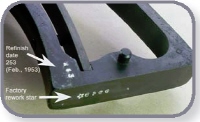
Typical factory refinish marks.
• B, N or S inside of a rectangle: Usage believed to have followed diamond marking. Sometimes noted as R-S or R-N (believed to stand for refinish-standard or refinish-nickel) on the grip frame under the grip panel.
Bear in mind that some of the above markings – particularly the star by the serial number – may indicate a return to the factory for some work other than refinishing. Also note that just as original-appearing factory markings can be stamped on a gun undergoing refinish or restoration by someone other than the factory, there is nothing (other than his conscience) which would prevent someone other than the factory who had refinished the gun from applying factory-style refinish markings.
In recent years, S&W has not marked factory refinished guns in any way. For many years they have declined to refinish older and antique models.
RARE BARREL LENGTHS
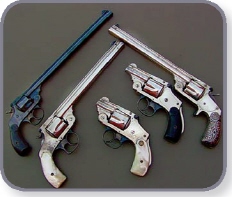
Rare barrel lengths will bring premiums when confirmed by factory letter.
Cataloged barrel lengths are nominal measurements only. Actual barrel measurement may vary as much as 1/8” from that listed. Revolver barrel length is measured from the front of the cylinder to the tip of the muzzle. Semi-auto barrel length is measured from the breech face to the tip of the muzzle.
Before paying a substantial premium for an unusual barrel length, inspect it carefully for signs of being cut, stretched, or replaced.
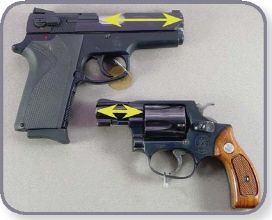
Measuring barrel lengths.
In most cases, markings on a barrel, such as S&W name and address and patent dates, are centered on the barrel in relationship to the barrel length. For example, the markings on the top of an original rare 6” American barrel will end closer to the breech end than they would on a standard 8” barrel.
Some shorter than standard barrels will have special markings in special locations, such as on the side of the barrel rather than on the top of the rib, due to lack of space for the full standard markings in the usual location.
Check to see that the barrel is both original to the gun in question (see section on matching serial numbers) and of the correct model. Many models will interchange barrels. For example, one of the authors has purchased on two different occasions what he thought was a rare 4” barreled New Model #3 only to discover the barrel was actually a common 4” barrel for the .44 DA. These would have been easy enough to detect by the lack of serial number or by the different patent dates, if only he had been a little smarter and a little slower to reach for his wallet. It is certainly possible that the factory used interchangeable model barrels rather than discard excess parts, but incorrect barrel markings will raise a red flag of caution for the careful buyer.
Look at the muzzle to see if its properly crowned, including the slight recess usually found on a barrel rib. Check the attachment and configuration of the front sight to be sure it’s factory type. Look at the finish of the barrel to see if it is consistent with the rest of the gun.
There is a restoration practice called “stretching” the barrel that has been used to restore cut barrels to their original length. Tip-offs for older stretched barrels include failure of rifling groves inside the barrel to line up perfectly and missing barrel markings. However, newer procedures consisting of relining the barrel interior and remarking the exterior are reportedly virtually undetectable to the naked eye. The problem of “messed with” barrels is not a new one. Consider this 1901 report from the Springfield Republican: “Four employees of Smith & Wesson’s shops, who were employed in boring barrels, were discharged on Thursday. It was found that when they had made a mistake and bored the barrels larger than they should be, they used a process to shrink them. This prevented their having to pay for the barrels as spoiled stock, but it turned out a bad barrel, as the bores were left at the right size at their ends, but too large in the center.”
Other Barrel Concerns: Guns which have been fired with an obstructed bore will sometime bulge the barrel. This may sometimes be visually observed as a high bright ring on the barrel or as a dark circle in the bore. Sliding the length of the barrel between thumb and forefinger will sometimes allow you to tactilely detect subtle bulges that are missed by visual inspection. Also check the rear of the barrel on revolvers for cracked or split forcing cones (often a problem on the tiny .22 Ladysmiths). Either a bulge or bad forcing cone will reduce the value of a revolver.
OTHER MODIFICATIONS AND UNUSUAL CONFIGURATIONS
The general rule is that any modification from the original configuration of the gun will adversely affect value. However, this is less true in some areas than in others.
Post-factory markings that confirm a known particular historical usage of a gun have always been an exception, and in many cases add to the value.
While condition collectors may have no interest in such items, collectors interested in the Old West may not object as strongly today as in the past to period of use modifications such as bobbed barrels or removed trigger guard spurs. A few years ago, the popular sport of cowboy action shooting, where participants assume Old West personae and compete with period firearms, had the effect of increasing the value of the S&W top-breaks in medium condition grades and provided a ready market for period altered guns that are otherwise mechanically sound. Perhaps regrettable is that many of the guns used in cowboy action shooting are refinished by their owners, which should further boost the value of original finish remaining on old S&Ws in the future.
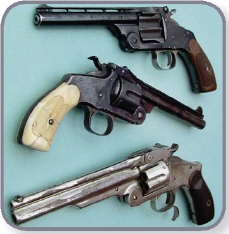
Eye of the beholder – unusual period non-factory alterations interest some collectors, turn off others. Top to bottom: New Model #3 converted to .22 single shot; modified sights, hammer & carved ivory grips on New Model #3; Russian Model with a .22 single shot barrel added on top of the .44 revolver barrel. Supica photo.
Factory errors do occur, and will bring a premium from interested collectors. However, they can also be the product of after-factory gunsmithing or fakery. The buyer should proceed with caution.
MATCHING SERIAL NUMBERS
To bring full price, serial numbers and assembly numbers on a S&W should match:
Early production revolvers used assembly numbers to designate which parts went with which gun. On these, the serial number was marked on the butt and the right grip panel, but a separate assembly number, usually one to four characters (usually either numerals or numerals combined with letters or special characters such as “&”), was marked on the grip frame under the grip panels and on the various major parts – usually cylinder and barrel on tip-ups and cylinder, barrel, and latch on top-breaks. The barrel number on top-breaks can be tricky to find – it is usually marked in the small flat just to the right of the latch (lifting the latch while the gun is open makes it easier to see).
In the 1870s the assembly number system was replaced by using the gun’s serial number on the major component parts.
On Hand Ejectors through the late 1950s, the serial number is stamped on the frame, barrel flat, cylinder face, yoke (crane), behind the extractor star, and right grip panel, in addition to on the butt.
After about 1960, revolvers had assembly numbers stamped on the frame, sideplate, yoke, and sometimes on the cylinder under the extractor and on some small parts. After about 1988, only the frame and sideplate are marked with assembly numbers.
The effect of a mismatched number on price is variable. Probably of least concern are situations where it appears there is a transposition error in numbers. An example would be where all parts except the cylinder are marked 4567 but the cylinder is marked 4576, although admittedly this is not common. Mismatched grips are not usually a major concern unless the grips are incorrect for the model, such as the occurrence of civilian grips on a military model that should have cartouches. On top-breaks, generally a mismatched latch is of less concern than other major parts. A mismatched top-break cylinder may be somewhat acceptable, especially if it is from a close serial number or from another gun in the same known usage (for example, many Japanese military New Model #3s are found with mismatched cylinders from other Japanese military guns).
However, where a barrel and frame don’t match, or none of the parts match, there will generally be a major impact on collector value. This is especially true when guns appear to be partially a rare model or configuration and partially a common type.
SMITH & WESSON STOCKS (GRIPS)
By James G. King II (Jim King)
Smith & Wesson called them stocks. Their catalogs persistently and specifically used the term stocks instead of grips. The reasons are not known, but a guess might suppose a company desire to be technically correct and to further the Smith & Wesson image of outstanding quality. Judging from their consistency in calling them stocks for over a century, it seems clear the distinction must have been important to S&W. With respect for S&W’s century of consistency, in this chapter we will generally continue S&W’s practice of calling them stocks.
It is important to keep in mind that dates mentioned in this chapter are not set in stone, but are approximate times of transition. Production changes were not necessarily immediate or absolute. There are overlaps, fluctuations back and forth between processes, frugal use of existing parts, special orders, and shipping dates that are not necessarily correlated to dates of manufacture. Almost all dates and time periods regarding S&W production are general guides and subject to variations and exceptions. The development and evolution of stocks is subject to similar uncertainties. Dates and time periods mentioned are approximate and based on observations, literature referenced, and factory literature.
While everything printed in this chapter is believed to be accurate, there are probably errors and inaccuracies. The scarcity of published information on S&W stocks leaves much to observation and analysis. It is hoped this chapter will be of assistance to S&W collectors and will contribute to expanding the body of knowledge about S&W stocks.
S&W STOCKS BY FIREARM TYPE
The following will provide a general understanding of the stocks found on most S&W firearms. It is a general outline only. There will be many variances.
Tip-Ups
Standard stocks on all tip-up models were smooth rosewood.
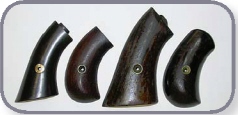
S&W Tip-Up Stocks. Left to Right: Model One 1st and 2nd Issues, Square Butt; Model One 3rd Issue, Round Butt; Model Two Old Army, Square Butt; and Model One-and-a-Half 2nd Issue, Round. All photos in the grips section by Jim King.
Top-Breaks
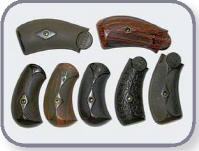
S&W small and medium frame top-break stocks. Top Row, Left to Right: Black Hard Rubber, .38 Single Action First Model Baby Russian, with S&W block logo; and, Red Mottled Hard Rubber, .38 Double Action Second Model. Bottom Row, Left to Right: Black Hard Rubber, .32 Single Action, without S&W logo; Red Mottled Hard Rubber, .32 Single Action, with S&W block logo; Black Hard Rubber, .32 Single Action, with intertwined S&W logo; Black Hard Rubber, Floral Pattern,.32 Double Action; and Black Hard Rubber, .32 Safety Hammerless.
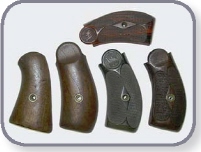
S&W large frame top-break stocks. Top Row: Red Mottled Hard Rubber, .44 Double Action. Bottom Row, Left to Right: Plain Walnut, American, Square Butt; Plain Walnut, Russian, Round Butt; Black Hard Rubber, New Model Number Three, Round Butt; and, Checkered Walnut, New Model Number Three, Round Butt.
Smooth walnut stocks were standard on the American, Russian, and Schofield models.
Hard rubber stocks were introduced in the late 1870s and eventually became standard on the top-break revolvers. They are the most common style of stocks on the New Model Number Three and .44 DA based models, with checkered or smooth (scarce) wooden stocks also available. Optional detachable shoulder stocks made of walnut were available on special order for the Americans, Russians, and New Model Number Three large frame topbreaks, with metal buttplate on the American &Russian shoulder stocks, and hard rubber buttplate on those for the New Model Number Three. Hard rubber stocks were fitted to nickel plated .38 Single Action First Model Baby Russians, but most of the scarce blued guns were fitted with walnut stocks.
Most hard rubber stocks had molded checkering with the familiar intertwined S&W logo in the stock circle at the top of the panels. Some exceptions were the early .32 centerfire single action stocks which first had no logo, followed be a block letter logo, and finally the intertwined S&W logo. Another exception was the Baby Russian, whose stocks had a block letter S&W logo in the stock circles.
Unusual hard rubber stock variations, worth a premium, include the rather striking red mottled stocks. This red/black combination was standard on the .320 Revolving Rifles (1879 - 1887), both for stocks and forearms, although for some unexplained reason, the forearms always seem to be more brightly colored than the stocks. Red mottled stocks may also be found on all frame sizes produced in the era from about 1879 to about 1882. Blue and green mottled variations have been reported.
An entirely different variation of hard rubber stocks, quite scarce, is found on some .32 Double Action Second Models. Called the floral, peacock, or wild turkey stocks, these have a molded floral pattern rather than checkering, with a bird that could be either a turkey or peacock lurking in the design.
Single Shots
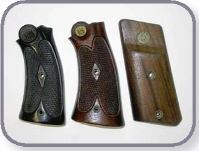
S&W Single Shot Stocks. Left to Right: Black Hard Rubber Target Stocks; Walnut Target Stocks, with gold medallions; and, Plain Walnut Straightline.
The First Model Single Shot (Model of 1891) pistols and combinations sets were typically fitted with hard rubber target stocks on their round butt frames. Plain and checkered walnut and fancy stocks of ivory and pearl were available on order. The Second Model .22 Single Shot had hard rubber target stocks as standard. The Third Model .22 Single Shot introduced in 1909 was typically fitted with checkered walnut target stocks, initially with gold plated medallions, but after about 1917 - 1920, without medallions. The Fourth Model .22 Single Shot (Straight Line) had plain walnut panels with gold plated brass medallions.
Early Hand Ejectors (1896 - 1950)
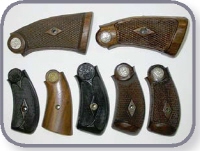
S&W Small Frame Hand Ejector Stocks. Top Row, Left to Right: Diamond Center Checkered Walnut, Regulation Police Extension Stocks, Pre-World War II (pre-war); and, Diamond Center Checkered Walnut, Regulation Police Extension Stocks, Post-World War II (post-war). Note variation in checking patterns. Bottom Row, Left to Right: Black Hard Rubber, Ladysmith 1st and 2nd Models, Round Butt; Plain Rosewood, 3rd Model Ladysmith, Square Butt; Black Hard Rubber, .32 Hand Ejector, Round Butt; Diamond Center Checkered Walnut, I Frame, Round Butt, pre-war; and, Diamond Center Checkered Walnut, I Frame, Round Butt, post-war.

S&W K Frame Hand Ejector Stocks. Although not pictured, N Frame stocks demonstrate the same variations, with the exceptions that hard rubber was not used and round butt frames were not available on production N Frames. Top Row, Left to Right: Black Hard Rubber, Round Butt, used 1899 to about 1940; Diamond Center Checkered Walnut, Round Butt, with silver medallions, post-war, used 1946 to about 1950. Bottom Row, Left to Right: Walnut, Square Butt, flattened top without medallions, used about 1904 to about 1910; Walnut, Square Butt, with recessed gold medallions, used about 1910 to about 1920; Walnut, Square Butt, round top without medallions, used about 1920 to about 1929; and, Walnut, Square Butt, with flush silver medallions, used about 1929 to about 1941.

S&W K Frame Hand Ejector Stocks, Inside Panel View. Although not pictured, N Frame stocks demonstrate the same variations, with the exceptions that hard rubber was not used and round butt frames were not available on production N Frames. Top: Walnut, Round Butt, with concavely rounded silver medallion, post-war. Left to Right: Black Hard Rubber, Round Butt; Diamond Center Checkered Walnut, Square Butt, with gold medallion; Diamond Center Checkered Walnut, Square Butt, no medallion; and, Diamond Center Checkered Walnut, Square Butt, with flush silver medallion.
Hard rubber was also the standard stock material used on early I-frame round butt Hand Ejectors from 1896 until about 1940, although checkered walnut also came into common use in the 1930s and was the standard on the .22/32 Kit Guns. Hard rubber was also used for oversized target stocks for the I frames, but was generally replaced by checkered walnut after about 1920. The Regulation Police style “stepped” grip frame was almost always fitted with checkered walnut extension stocks.
While hard rubber was the early standard on round butt K frames, checkered walnut stocks were also fitted. The square butt K frames introduced about 1904 and the N frames introduced about 1907 were fitted with checkered walnut stocks as the standard.
Hand Ejector stocks evolved through a series of progressions that produced numerous variations in stock circles, medallions, checkering patterns, stock circle inserts, screws and escutcheons, and general configurations. The following will describe the major changes.
Until about 1910 wood stocks had a flattened or slightly convex area at the top of the stock panels in an area called the stock circle. Around 1910, (earlier for I frames, later for N frames) recessed, gold plated brass medallions bearing the intertwined S&W logo were added to Hand Ejector stocks. A small medallion, about four tenths of an inch in diameter, was used on I frame stocks. A larger medallion, about a half-inch in diameter was used on K and N frame stocks.
When WWI interrupted commercial production, the 1917 Army revolvers were fitted with plain walnut stocks without medallions, the earliest ones having the flattened tops and later ones having plain concavely rounded stock circles. Beginning in 1917 (with overlap to perhaps 1920), the medallions were eliminated and the stock circles became plain and concavely rounded, like the later version of 1917 Army stocks.
About 1929, flush chrome plated brass medallions bearing the S&W intertwined logo began to appear in the stock circles. The small medallions, about four tenths of an inch in diameter, were used on both I and K frame stocks. The large medallions, about a half-inch in diameter, were used in the N-frame stocks, although some K-frame stocks also used them.
In 1932 the Wesson Grip Adapter was introduced for N frames, with the K frame version becoming available in 1934. The adapter consisted of two blued steel plates which fit between the stock panels and the grip frame, secured by an extra long stock screw provided with the adapter. The plates had forward extensions which held a rubber filler piece between them with a screw so that it filled the area below the frame between the trigger guard and the grip frame. The filler piece positioned the shooting hand lower on the grip frame so that the trigger finger was more in line with the trigger, and it provided a surface for supporting some of the revolver’s weight on the middle finger. The filler piece had been promoted by Walter Roper as an aid to target shooting and was usually incorporated into his custom stock designs, later to become a standard design component of virtually all target stocks for revolvers.
Another type of grip adapter consists of a metallic or synthetic rubber filler piece that extends downward along the front strap to provide a larger, more comfortable grip for most shooters. This type of grip adapter is secured to the front strap by a thin metal strip bent around the strap. When the stocks are installed over the metal strip, they generally do not fit snugly due to the thickness of the strip. For this reason, it is fairly common to encounter stocks that have been altered by removing enough wood from each panel to allow them to fit snugly over the strip. This type of adapter became available around WWII and was made by Pachmayr and others. S&W produced its own version in about the 1950s. They were used on many, if not most, police revolvers prior to the popularity of replacement rubber grips such as Pachmayr’s.
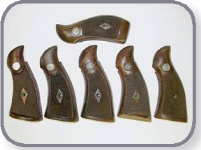
S&W K Frame Magna Stocks. Top: Diamond Center Checkered Walnut, Round Butt, post-war, used about 1950 to about 1967. Bottom Row, Left to Right: Diamond Center Checkered Walnut, Square Butt, prewar, used about 1936 to about 1946; Diamond Center Checkered Walnut, Square Butt, post-war, used 1946 to about 1952, Diamond Center Checkered Walnut, Square Butt, post-war, used about 1953 to about 1967; Diamond Center Checkered Walnut, Square Butt, Plain Clothes, post-war, used 1952 to about 1967; Checkered Walnut, Square Butt, used about 1967 to about 2000.
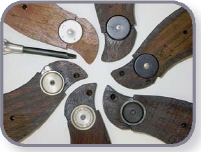
S&W K Frame Magna Stocks, Inside Panel View. Counterclockwise from screwdriver tip: Diamond Center Checkered Walnut, Square Butt, pre-war, with unmarked in-the-white machined steel stock circle insert, reported to be early production; Diamond Center Checkered Walnut, Square Butt, pre-war, in-the-white machined steel stock circle insert stamped with patent marking, reported to be later production; Diamond Center Checkered Walnut, Square Butt, with blued machined steel stock circle insert, very early postwar, used 1946; Diamond Center Checkered Walnut, Square Butt, with blued stamped steel stock circle insert riveted by concavely round medallions, early post-war, used 1946; Diamond Center Checkered Walnut, Square Butt, with blued stamped steel stock circle insert, without relief hole for domed-head rear sideplate screw (which was replaced by a flat-head screw), post-war, used about 1946 to 1973; Checkered Walnut, Square Butt, with stamped stainless steel stock circle insert, used about 1970 to about the early 1990s.
In 1935 Magna style stocks were introduced as an option for the .357 Registered Magnum and other N frames. In 1936, Magna stocks became available for the K frames. Magna stocks cover the grip frame like standard stocks, leaving front and rear straps exposed, but have a “horn” on each panel that comes up on the side of the frame along the backstrap, providing a wider surface to spread the force of recoil at the web of the hand between thumb and forefinger. After WWII, Magna stocks became the standard for Hand Ejectors.
During WWII, the Victory Model stocks were plain walnut without medallions, and concavely rounded plain stock circles. The stock screw thread was changed to a standard thread about 1944 during wartime production. The earliest .38 M&Ps shipped after WWII were fitted with leftover plain walnut Victory stocks fitted with pre-WWII style flush chrome plated medallions.
Beginning in 1946, several significant changes to stock design were introduced, made possible by new machinery at the factory. The chrome plated silver medallions were changed from flush to having a rounded surface to match the contour of the stock wood. The checkering was modified from the prewar standard 16 lines per inch to 14 lines per inch, with rounded instead of sharp corners and a different border for the checkered area. The stock circle insert was changed from a machined steel disk to a stamped, cup-shaped, blued steel disk.
From the beginning of the use of checkering on S&W stocks, including the hard rubber stocks, a diamond-shaped area around the escutcheon and escutcheon nut was uncheckered. Stocks having this checkering pattern are often called “diamond checkered stocks” or “diamond stocks.” This nomenclature is somewhat awkward and causes confusion because every point in the checkering is diamond-shaped due to the angled lines cut by the checkering process, causing many to believe that all checkered S&W stocks are diamond “something.” The term “diamond center” is also used and seems likely to be the most clearly descriptive of the names. The diamond center description will be utilized in this chapter. The diamond center checkering pattern was eliminated about 1967-1968.
Modern Hand Ejectors (1950 to Date)
By about 1950, Magna stocks were standard on all Hand Ejectors. Perhaps due to a worldwide shortage of precious metals following WWII and continuing into the Korean War (or Conflict, depending on how the political hairs are split), the chrome plated brass medallions were replaced with molded silvery-gray plastic medallions complete with intertwined S&W logo. Plastic medallions were used until about 1952 when they were replaced with steel medallions. By about 1953, the use of plated brass medallions had resumed. In 1952, the Plain Clothes (PC) style square butt Magna stocks were developed with a rounded bottom and more rounded front shoulder on the horn. The slimmer, more rounded shoulder on the front of the horn would soon become the standard, replacing the sharp shoulder configuration of the horn which had been used since the introduction of Magna stocks.
About 1967 - 1968 the uncheckered diamond center around the escutcheon and nut were eliminated on all checkered wood stocks. About 1973 the escutcheon and nut that had been used since introduction of hard rubber stocks in the late 1870s were changed. The hollow-round, silver-colored style which was installed with the edges flush with the stock surface was replaced with a flat, recessed, brass style which would be used until S&W’s factory wood stocks were discontinued in the 1990s. About this same time, the stock circle insert was changed from blued steel to stainless steel as standard for all revolver stocks, although the stainless steel version had been in use on stocks for stainless steel guns since the early 1960s.
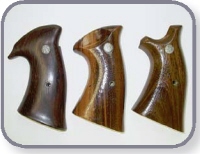
S&W Plain Target Stocks. Left to Right: Early Smooth Rosewood “Coke Bottle,” Square Butt, without extractor relief cut, used early 1950s; Smooth Goncalo alves, Square Butt, with extractor relief cut, used about 1967 to about 1980; Smooth Rosewood, Square Butt, with speed loader cut, without stock circle insert, used about 1970s to early 1990s.
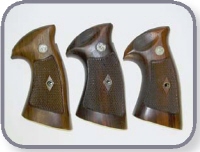
S&W Diamond Center Checkered Target Stocks. Left to Right: Early Diamond Center Checkered Walnut, Square Butt, without extractor relief cutout, used early 1950s; Diamond Center Checkered Goncalo Alves “Coke Bottle,” Square Butt, with extractor relief cut, used about 1955 to about 1968; Diamond Center Checkered Goncalo alves, Square Butt, with extractor relief cut, used about mid-1950s to about 1967.
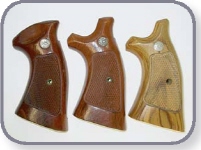
S&W Checkered Target Stocks. Left to Right: Goncalo alves Checkered Target Stocks with extractor relief cut, dated 1978; Goncalo alves Checkered Target Stocks, with speed loader cut, dated 1981; and, Resin Impregnated Laminated Birch Checkered Target Stocks, with speed loader cut, from the early 1990s. Note the distance separating the medallions from the checkered panels. The close spacing on the right panel is typical of late stocks made without stock circle inserts.
Target stocks that covered the front strap and extended up over the gun’s frame between the trigger guard and knuckle were introduced for the K frames in 1950, followed be the N frames by 1952, and apparently a little later for the J frames. The earliest target stocks did not have a relief cut at the top of the left panel behind the cylinder. Their full contour made extraction of spent cartridges somewhat difficult, with used stocks often wearing dents from the cartridge rims in this area. By the mid to late 1950s, an extractor relief cut had been added to the left panel to solve this difficulty. By the mid 1970s (early 1980s for N frames) a larger speed loader cut was incorporated to allow speed loader use with target stocks. The changes in checkering pattern, escutcheons, nuts, and stock circle inserts on target stocks paralleled the Magna stock changes outlined above. In the 1980s, the stock circle inserts were eliminated entirely and replaced with a rounded boss in the wood which fit against the gun’s frame. On this style of target stock, the medallions were secured by riveting the end of the post against the stock wood.
One variation of target stocks draws special interest from collectors. “Coke bottle stocks” were introduced for K and N frame target revolvers in the mid 1950s. These very desirable stocks were made in both plain and diamond center checkered versions. (Checkered versions are scarce in K frame. Beware of altered N frame stocks represented as original K frame.) Rosewood is the most common material, but Goncalo Alves and to a lesser extent, walnut, were also used. The diamond center checkered version was standard on early .44 Magnums and is fairly common on early Model 57s, but could be ordered on other models, or purchased as an accessory. The Coke bottle name reportedly comes from the shape of the stocks when viewed from the rear. The resemblance to a Coke bottle requires some imagination, but there is a little swell in the middle around the screw and a little flare at the butt. On early examples, the filler piece is generally larger than on most other target stocks, giving them a distinct shape. On the more common diamond center checkered version, the checkered area is larger than on other S&W target stocks, providing a distinct appearance. With their unique shapes and beautiful woods, the Coke bottle target stocks are perhaps the most visually striking of all S&W wood stocks.
The J-frame revolvers are the smaller, lighter frame size which is often chosen for everyday and concealed carry. Since size matters, the J-frame revolvers have usually been offered with tiny wood “splinter” or “sliver” stocks so as to minimize their size. The Centennial and Bodyguard models have special Magna stocks called “high horn” stocks with enlarged horns that come up higher on the sides of the frame. Custom stock maker Craig Spegel developed a custom boot grip designed to provide a larger, more secure gripping surface without substantially increasing the gun’s bulk. Variations of boot grips by Hogue, Eagle, Uncle Mike’s, Ace Grip Co., Altamont Grips, and others have been used as standard on modern S&W revolvers, especially short-barrel J frames.
By about 1975 Goncalo Alves became the standard wood for oversized target stocks for all frame sizes. Target stocks also became standard on many large frame guns. Traditional wood stocks were largely discontinued in favor of synthetic and laminated wood stocks in the 1990s.
The round butt configuration for revolvers has proven popular due to versatility related to its smaller nominal size. While it readily fits the smaller hand, a change of grips can adjust the grip size to custom fit a larger hand, or convert it to square butt grip configuration. Accordingly, S&W has phased out square butt guns in favor of a product line featuring all round butt revolvers.
There is an interesting cycle here which has repeated twice over 150 years of revolver production. All the earliest tip-ups had square butt grip frames, but by 1868, all except the No. 2 Old Army had been changed to round butt. Americans, 1st Model Russians, and Schofields had square butts, but their successors, the New Model Number Threes, had round butts. The round butt was standard on all S&Ws by 1878. By 1891, hard rubber extension stocks had become available for the single shots and combination sets to convert the round butt to square butt configuration for target shooting. With the introduction of the square butt on the .38 and .32/20 M&P Models of 1902, First Change in 1904 (the square butt configuration was called the Model of 1905 by S&W to distinguish it from the earlier round butt configuration), the square butt began to make a comeback. With the ever-present possible exception of a special order, all N frames since 1907 were square butt. In 1917, the Regulation Police stepped grip frame and extension stocks were introduced to provide a square butt configuration for certain I frames. By WWII, square butts dominated the K frames and round butts were scarce except on the small frame revolvers. After WWII, round butt guns continued in production, but were vastly outnumbered by square butts. Recently, after nearly 100 years of producing mostly square butt revolvers, S&W has again reverted back to round butt as the standard, with the square butt configuration available by installing conversion stocks when desired.
Semi-Auto Pistols
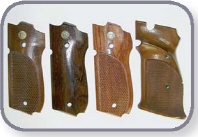
S&W Automatic Pistol Stocks. Left to Right: Walnut Checkered Panel for Model 39; Rosewood Plain Panel for Model 39; Rosewood Checkered Panel for Model 39; and, Walnut Checkered Panel for Model 41.
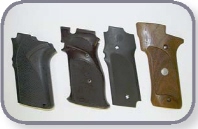
S&W Automatic Pistol Stocks. Left to Right: Xenoy Wraparound Grip used on 2nd and 3rd Generation Pistols; Red Nylon Panel for Model 46; High Impact Plastic Panel for Model 845; and, Synthetic Wood Panel for Model 422.
Beginning with the .35 Semi-Automatic Pistol in 1913 and continuing with the .32 Semi Auto, the Models 39, 41, 46, and 52, S&W fitted its semi-auto pistols with walnut (and occasionally fancy wood) stock panels. Beginning with the Model 59 in 1971, the trend has been toward more durable synthetic materials. There have been exceptions, as wood panels were tried on some second-generation guns, but the very thin wood panels tended to split under recoil. Third-generation centerfire semi-autos are made exclusively with one-piece wraparound synthetic Xenoy grips, which play a large part in their improved handling characteristics. For most third generation models, replacement Xenoy grips can be had from S&W with either straight or curved backstraps to fit the shooter’s preference. Some recent variations include various inserts which can be changed to adjust the size of the curved backstrap.
Long Guns
The stocks and forearm of the .320 Revolving Rifle were red mottled rubber while the detachable buttstock was walnut with a hard rubber butt plate bearing the S&W logo, and blued or nickel plated steel attachment hardware with a mounting point for the tang sight. Sporting Rifles were typically fitted with American walnut stocks. S&W shotguns were usually fitted with American walnut stocks on sporting models, and wood or synthetic stocks on law enforcement versions.
FACTORY STOCK NUMBERING
From the beginning of commercial production and continuing up to the mid to late 1970s, S&W stocks were “numbered” to the gun to which they were originally fitted. The gun’s serial number was marked on the inside of the right stock panel (the one on the right when the gun is upright with the muzzle pointing straight away). The serial number marking did not include any prefix, which could be a letter or numbers and a letter, except for some Victory Model stocks which did include the letter prefix.
From the Model 1, beginning in 1857, wooden stocks were usually marked by individually stamping the digits of the serial number. Black hard rubber stocks were introduced on the Model 1-1/2 Centerfire in about 1878 and received the same stamping treatment. Sometime before 1900, the stamping method of marking was replaced with pencil numbering on wood stocks and scratched numbering on hard rubber stocks. About the time when silver medallions were added to wooden stocks around 1929, stamping again became the standard method of numbering stocks to guns. Around the mid-1960s, the stamping was changed from individually stamped digits to a straight line stamping near the bottom of the right panel. The practice of numbering stocks was discontinued in the mid to late1970s when production methods developed tolerances sufficiently close to allow stock installation on guns without individual fitting.
CONDITION AND PRICE GUIDELINES FOR S&W STOCKS
Evaluating Condition of S&W Stocks
To effectively use the price guide for stocks, it is important to understand the definitions of the terms used to describe condition. The following condition grades are based on the amount of wear and damage, factory defects, and the presence of repairs or alterations. The condition grades presented here have been developed for stocks suitable for collector grade guns, where condition is usually important. These terms are specifically developed for use in grading S&W stocks and do not apply to guns or other items.
NEW: New stocks are in the same condition as when they left the factory. Other equivalent terms are Mint, Perfect, or 100%. This means no scratches or rubs on the finish, no dents on sharp edges or anywhere else, no damage to sharp corners or the tips of the horns, no distortion to the grip pin holes from installation on a gun, no broken points on checkering, and no damage to the screw head. This also means no factory defects, which are not uncommon on S&W stocks.
EXCELLENT: Excellent means nearly new, except with no more than two minor defects or spots of damage. Minor defects and spots of damage are: scratches no more than one half inch in length on the surface of, but not through, the finish; rubs or very minor surface abrasions on the finish not more than one quarter inch in the longest dimension; small dents less than one eighth inch in the longest dimension which are not obvious, but apparent on close examination; no more than two broken points in any one location in the checkering; tiny splinters of wood no more than three sixteenths inch in the longest dimension missing on any sharp corner or sharp edge; no more than one small factory defect such as uneven sanding, tiny chip removed prior to finishing, medallion not seated perfectly flush, medallion slightly rotated, or stock circle insert poorly riveted; or, grip pin holes slightly enlarged from installation on a gun. Excellent grips are not perfect, but it takes close examination to see the defects. Excellent condition grips are good enough to put on a 99% gun.
GOOD: Good stocks show minor honest wear. Minor honest wear means: tips of diamonds in checkering are flattened by light wear; no more than 10 checkering points broken in any one place with no more that two such damaged areas; noticeable small dents up to one quarter inch in the longest dimension, but no gouges where wood is missing; scratches up to one inch in length may be through the finish, but no patches of finish missing; factory defects which are obvious such as rotated medallions, medallions protruding significantly above the wood surface, minor chips removed before the finish was applied, or badly riveted stock circle inserts; or, minor chips up to one quarter inch in the longest dimension which do not detract from overall good appearance. Good condition stocks include those that would otherwise qualify as excellent except for a repair or refinish which is only apparent on close examination. Good condition stocks are good enough to put on a 90% gun.
FAIR: Fair condition stocks show substantial wear and tear. Signs of substantial wear and tear include: almost all points of checkering are worn smooth on the tips, and areas of checkering no larger than one inch in the longest dimension may be worn smooth; more than six significant scratches through the finish; dents larger than one quarter inch in the longest dimension which are easily noticeable without close examination; patches of finish missing up to one inch in the longest dimension; chips up to three eighths inch in the longest dimension; repairs to escutcheon or nut, grip pin holes, medallions, or stock circle inserts; minor cracks up to one inch in length; obvious, but correctly done refinish; or; very minor sanding of bottom edges to remove small chips or dents. Fair condition stocks may include Good or Excellent condition stocks that are missing parts that can be easily replaced or excellent condition stocks that can be salvaged by a quality refinish. Fair condition stocks are good enough to put on an 80% gun.
POOR: Poor condition stocks are generally not suited for collector interest except as examples of rare variations or to install on rare guns in poor condition. Poor condition means: worn out, badly damaged, or abused; checkering worn off in areas larger than one inch in the longest dimension; obvious chips; deep scratches into the wood; large areas of finish missing; gouges where wood has been removed; altered, carved, or sanded; poorly refinished; or missing parts such as escutcheons, medallions or stock circle inserts. Poor condition stocks are generally not good enough to put on a collectible gun, but may be useful on a working gun or a shooter.
Fancy Stocks
Fancy stocks of pearl, ivory, stag, exotic wood, or other material were available both from the factory on order and from non-factory aftermarket suppliers. Aftermarket suppliers continue to produce fancy stocks today. Beginning about 1893, factory-produced pearl and ivory stocks had small round S&W medallions inlaid, to distinguish them from non-factory stocks. Revolver boxes from this era may be found with a flyer glued on the bottom inside urging buyers to insist on genuine S&W stocks with the medallions. Pearl stocks with gold medallions in excellent condition may be worth $150 to $300 or more depending on model and frame size. Factory pearl stocks without medallions in excellent condition may be worth $50 to $100 depending on frame size.
Period pearl or ivory stocks will usually bring a premium on antique S&Ws. Exceptions would include rare variations that had a unique stock, such as military guns with inspector cartouches on the wooden panels, or a special order gun missing its special order fancy stocks. In the 1800s, pearl was considered the more deluxe and desirable stock material, resulting in more pearl stocks sold than ivory. The result is that ivory stocks are scarcer and will bring higher market prices from collectors today. Genuine S&W fancy stocks are generally worth more than aftermarket stocks.
Pearl and ivory stocks may be found decorated by checkering, inscription, or relief carving. Pearl grips were more difficult to work due to their brittleness and the toxicity or the dust created. To minimize these hazards, pearl was reportedly worked under water in a water bath. Decorated exotic stocks tend to bring an additional premium due to the additional craftsmanship of the decoration. An excellent set of old ivory stocks with high relief carving for a large-frame single-action may be worth $1000 or more by themselves without a gun to wear them.
Aftermarket ivories will usually bring a premium, if genuine ivory and not a modern synthetic imitation (sometimes made with ivory dust imbedded in polymer). Ivory stocks will tend to mellow with age, the grain may become more pronounced and slight crazing or cracking may appear. Pearl may also tend to yellow slightly. The aged appearance of yellowing (and minor cracking on ivory) will generally not detract from value if consistent with the age and condition of the gun, and may actually enhance value by providing a visual appearance that gun and stocks are of the same vintage. An aged appearance can be artificially created, however. See the discussions of pearl and ivory stocks in the stock materials section for information on evaluating authenticity.
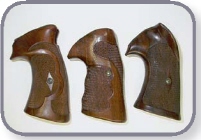
Custom Target Stocks. Left to Right: Griffin &Howe Checkered Walnut Custom Target Stocks, with Roper-style checkering pattern; Cloyce Checkered Walnut Custom Target Stocks; and, King Gun Sight Company Checkered Walnut Right Hand Thumbrest Custom Target Stocks.
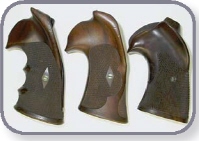
Custom Target Stocks. Left to Right: Roper Checkered Walnut Custom Target Stocks; Roper Checkered Walnut Custom Target Stocks; and, Lew Sanderson Checkered Walnut Custom Target Stocks.
Custom wooden stocks by noted makers may bring a premium or be collectible on their own. Custom target stocks by Roper, Kearsarge, King Gun Sight Company, and Griffin &Howe attract considerable collector interest. Other custom stocks by lesser-known makers like Herrett, Cloyce, Fitz, and Fuzzy Farrant are not easily identified or well known and fail to draw much notice. Mass production wood stocks by Herrett, Sile, Mustang, Eagle, and others, along with synthetics by Franzite, Jay Scott, Rugged Products, Tyler Tru-Fit, Fitz, and numerous other makers will usually reduce a gun’s value. Whether aftermarket or incorrect era factory replacements will enhance or detract from gun value will depend on the desirability of the stocks on their own, whether they are correct for the period, their condition, and the scarcity and cost of the standard stocks that should have been on the gun.
General Price Guidelines
As a general guideline, a pair of regular production stocks should be worth about ten percent of the value of the gun for which they were produced. However, there are many exceptions.
The most common stocks for guns produced in large quantities will not normally fetch such prices. For example, J and K frame round butt checkered walnut Magnas and K-frame square butt walnut checkered Magnas are quite common and will bring five to seven percent of the value of a common gun in like condition. Synthetic stocks for semi-auto pistols may not draw buyer interest when priced at $10 or less. In contrast, pre-pg014- WWII K and N frame Magnas in excellent condition from the late 1930s may equal or exceed the value of the more common guns of that era.
The stock value tables in this section provide estimated values for regular production stocks that exceed the ten percent guideline or have significant collector interest. The tables do not include fancy stocks, stocks for antiques, semi-auto stocks, aftermarket stocks, or common stocks with minimal collector interest whose value is consistent with the ten percent guideline. Values are based on recent sales transactions.
In the stock value tables, the word “diamond” is substituted for “diamond center” and indicates checkering around a diamond-shaped uncheckered area around the escutcheon and nut. “Checkered” means checkered without a diamond-shaped uncheckered area around the escutcheon and nut, while “plain” means smooth, without checkering. “RB” means round butt and “SB” means square butt. Other terms and materials are discussed elsewhere in this chapter and in the Illustrated Glossary and Index.
STOCK PRICE GUIDE TABLES
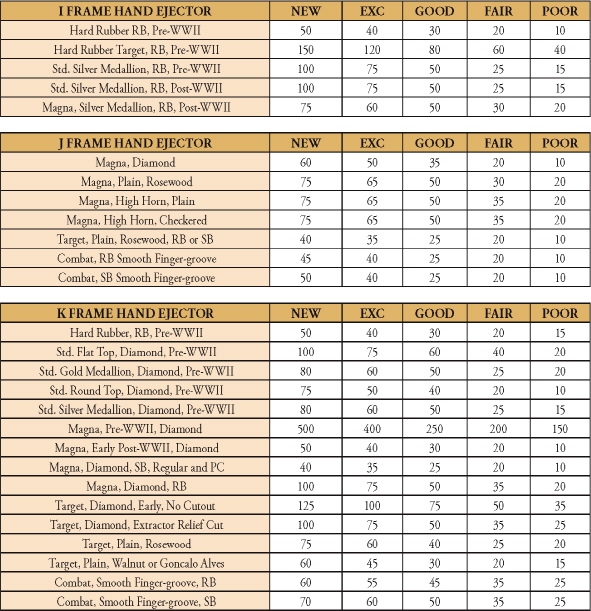
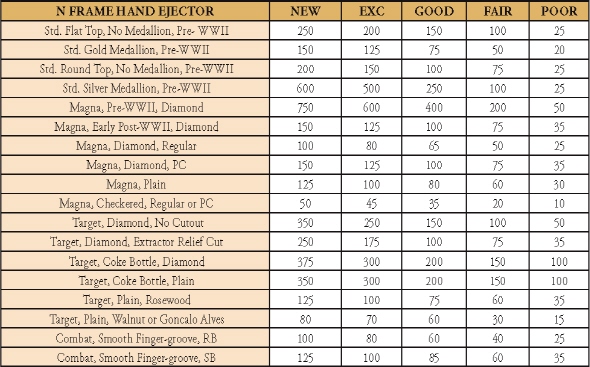
References
Jinks, Roy G., Personal Communication, 2005
Neal, Robert J. and Jinks, Roy G., Smith & Wesson 1857-1945, Revised Edition, R & R Books, Livonia, NY, 1996.
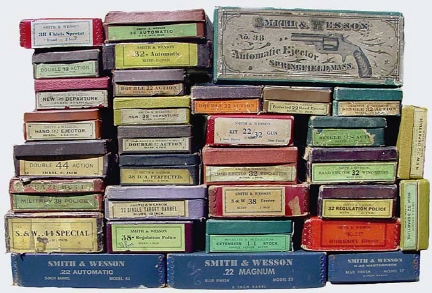
S&W boxes. Old Town Station Dispatch photo.
A BRIEF CHRONOLOGY OF BOXES &ACCESSORIES
by Dave Ballantyne and Dick Burg
Boxes and their contents (cleaning and sight adjustment tools, instruction papers, wrapping, etc.) are not a universally accepted subset of S&W collecting. Some collectors have no interest at all while others see it as an integral and valuable addition to the gun itself. Perhaps part of this is due to the challenge involved, as the survival rate of such ephemera is generally lower, much lower, than that of the guns themselves.
Many of the boxes found with handguns today are not original to the gun. Large numbers of them have been separately collected from online auctions, gun shows or even yard sales and mated to the gun with the specific intention of increasing the guns value or desirability. The authors take no position on boxes but would caution collectors that purchasing a box for $X does not necessarily increase the value of your prized gun by an equal amount. In general, having the truly original box increases the value more.
As with all things relating to collecting firearms, condition and rarity will be the determining factors for pricing boxes. It’s impossible here for us to give definitive prices for all the variations that exist. However rare boxes can fetch enormous prices. In at least one exceptional instance over $4000 was paid to purchase a numbered box in order to reunite it with the original gun. As with any purchase, learn as much as you can about your subject before you buy – check out what similar items sell for on the internet sites, talk to those more knowledgeable on online forums or at gun shows. As a very rough guide we offer the following based on observations of the 2006 market:
• Blue boxes from the 60s/70s should sell for around $20
• Gold boxes vary greatly on the model but in general $50 - $75 is a reasonable for a good condition example. K-22s, .357 Magnums and others are $125 and up
• Labeled two-piece maroon boxes from $50 to many hundreds; very model dependent
• Display or patent boxes from $150 upwards, depending on the model
• Picture boxes (red or blue) generally begin at $300; the sky’s the limit here....
At time of writing S&W has been making firearms for some 154 years. During that time it has used many containers for its products, some of them for many years and some for only a few months. As most collectors know, S&W has always been a frugal and prudent manufacturer and discontinued older parts have often found themselves being utilized when urgently needed on the production line. The same is true of spare boxes.
For example, if S&W had none of the correct boxes in stock they would use what they did have until stock was obtained. In evidence of this there are numerous examples of guns shipped in “unusual” boxes, properly labeled but in the wrong style or color. On other occasions S&W would continue to use up stock long after standards had been altered. As an example of this situation consider the infamous gold boxes with embossed blue model specific lids. These were introduced after WWII and phased into use on a model by model basis from 1946 onwards. They were mostly phased out again from the mid-late 1950s when stocks began to run down. S&W continued to use them for certain slow selling models such as the K-32 until the mid 1960s, long after similar gold boxes for faster selling models had been phased out.
For the reasons stated the authors offer the dates below purely as a timeline guide for the S&W collector, not as “hard” information. There will be variations on a model by model basis and, as with everything else about collecting S&Ws, there are always exceptions to the rules.
IMPORTANT NOTE: Many of the dates given overlap – this is correct and intentional.
BOXES
1852 – 1900: Cases
Special permanent cases for the storage of side arms, especially fancy or presentation arms, were popular during the second half of the 19th century. In general these were special order items or were added by the distributor after shipment from the factory.

Gutta percha cases for Model Ones. Photos by Jamie Supica.
Model One 1st and 2nd Issues are sometimes found with “gutta-percha” or shellac type cases and are generally considered to be correct for these models. These types of case are discussed further in the section on Tip-Up Revolvers. Both wooden and leather-covered wooden cases have been found for most tip-up and single action top-break revolvers.
The only wooden case of that period that was actually manufactured by S&W was for the Model 1-1/2 Single Action Centerfire, aka the .32 Single Action. This particular case is tri-sectioned on the interior and has a gold-embossed black “Directions for Use” label glued inside the lid.
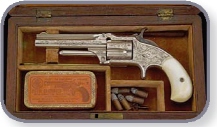
M.W. Robinson style wooden case. Photo courtesy of David Carroll.
Other standard wooden cases were offered by the larger distributors such as M.W. Robinson and have come to be considered as “factory” by collectors. A particular style considered to be an “M.W. Robinson” style case has a hinged wooden lid that fits over a raised wooden inner lip on the bottom portion of the case. The interior is partitioned, with a large area for the gun with a notched brace piece under the barrel, and two smaller compartments, the larger of which is usually sized to fit a box of cartridges. The interior is lined with fabric of various colors. A key to identifying this type of case is to look at the bottom, which was made out of a lower quality “box wood” than the well finished sides & lids. Relined cases can often be identified by the lack of wear & stains on the fabric lining. Double casings are especially prized by collectors, particularly in those rare situations where two different models were cased together (often a holster pistol with a smaller pocket pistol).
AUCTION BLOCK
Double cased pair – No. 2 Army & Model 1-1/2 New Model cased together, “factory wood case… very fine…85% (M.2)…90-93% (M1-1/2)” - $24,150 - Amoskeag, Garbrecht collection, Sept. 2005.
Double cased pair – 1st Model Russian, 98%, with Model 1-1/2, 99%, both ivory stocked, “dealer cased” – $28,750 – same auction.
Wooden cases were especially popular in England and France. While features vary, some characteristics typical of many British casings include oak exterior, often with a brass or other metal oval inlay in the lid for the owner’s monogram; fabric lined partitioned interior; and frequently a dealer’s or arms maker’s paper label on the interior of the lid. Instead of partitioned interiors, “French-fitted” cases have interiors with cutouts exactly fit to the contour of the gun and other accessories.
Special cases were still used well through the turn of the 20th century, observed more often with top-break revolvers than with Hand Ejectors. As time moved on, leather lined exteriors gained in popularity. The factory offered a special casing for its “combination sets,” each set consisting of a 38 SA 3rd Model revolver (Model 1891) with one or more single shot barrels and accessories – usually an extra set of grips, screwdriver and cleaning rod. Two types are known, one with an oak exterior and the other a Moroccan leather exterior. Both were chamois lined. A similar type casing was offered for pairs of single shot pistols. Either is quite rare.
Cleverly made reproductions of period cases have been in circulation for many years. Differentiating between the original and the reproduction is an arcane art mastered by relatively few collectors. Some pretty spectacular and convincing looking “special casings” have been fabricated out of legitimately old jewelry boxes and silverware cases.
Wooden cases for special individual guns or for special models have remained available, both through S&W and aftermarket suppliers, to the present day.
Early Two-Piece Cardboard Boxes: 1852 - 1880s
Throughout most of S&W’s history, the majority of guns have been shipped in cardboard boxes.
Early Two Piece Cardboard Boxes: It is believed that the earliest S&Ws were shipped in mottled two-piece blue, green, or black cardboard boxes.
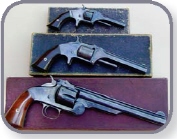
Original boxes for Model One & Model Two. Model Three box (bottom) may be a later than period-of-manufacture factory repair return box. Old Town Station Dispatch photo.
Some original cardboard boxes for the Model 1 and Model 2 have been observed as two-piece, covererd with black texture patterned fabric. Different patterns have been observed on the exterior, and the upper lip of the bottom part of the box is seen lined with light blue paper. Others are observed with various colors of mottled exteriors. It is believed these boxes had neither interior nor exterior labels. They are quite rare, and one in nice condition has been known to sell for thousands of dollars.
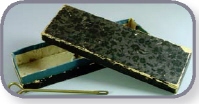
Original box for Model One.
It is unknown what boxes were used for the earliest Model Threes. An American has been observed in a two piece unlabeled maroon box, but it is believed that was likely an early factory return box, used to ship the gun back to its owner after an early factory rework, later than the period of manufacture.
Late 1870s - Early 20th Century: Hinged Lid Boxes
The hinged lid cardboard boxes consist of fabric covered cardboard with the lid connected to the box. Many of these boxes survive with fabric tape hinges intact, perhaps surprisingly, although the corners often suffer from insufficient support and are prone to tearing.
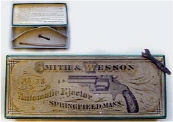
Original Baby Russian box, with combination tool. Old Town Station Dispatch photo.
This appears to have been first used on the 38 SA 1st Model “Baby Russian,” which has the only “picture box” from this era. The green box has a fancy paper label on the lid with a picture of the gun and gold highlight (which fade rapidly), with cardboard partitions on the inside. The 38 SA 2nd Model and the .32 SA had similar green boxes, with the .38 SA having an oval top exterior label. These boxes also probably introduced the interior lid “Directions for Use” informational labels, which continued for a long time in S&W cardboard boxes.
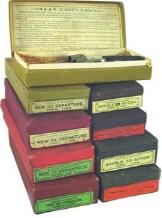
.32 & .38 Double Action and Safety Hammerless boxes. Unattributed photos in the box section are from ArmsBid.com.
From about 1880 S&W began to use a wide variety of colors including black, brown, maroon, mustard, blue, and red. Presumably the colors were originally used to differentiate models in some way but this knowledge has been lost to us over the years, although many theories have been put forward. Many .32 and .38 DAs are observed in brown hinged lid boxes, with many Safety Hammerless models showing up in mustard boxes for .32 cal. and red or maroon for .38. The 3rd Model Single Shot is found in a lavender colored box. Reddish-brown seems to be the most common color for early Hand Ejector hinged lid boxes.
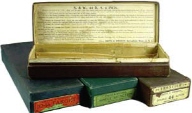
Late Model Three boxes. Supica collection.
The New Model Number Three and .44 DA families of models may be found with these hinged lid boxes. Green has been observed for the New Model No. Three, brown for the .44 DA Models (with an additional “Frontier Model” end label on the lid for that variation), and dark blue for a New Model No. Three Target Model. These boxes are rather scarce, and it would be difficult to draw hard and fast conclusions from the number observed. Oddly, the most commonly found box for the Model 3 family is the green box for the scarce extension shoulder stocks for the New Model No. Three. It seems a stash of these shoulder stocks still in the original boxes turned up several decades ago.
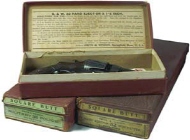
Early hinged-lid Hand Ejector boxes.
Also around 1880 S&W began to use end labels to describe the contents of each box. Initially this was used on the Double Action models. A green label generally designated a blued gun, with nickel guns packed in boxes with orange or white end labels. The serial number is usually marked in pencil or grease pencil on the bottom of the box.
Beginning Late 1920s:
The Patent or Display Box
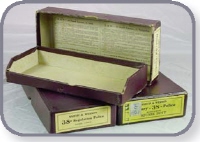
Patent boxes.
Around the end of the 1920s S&W introduced a new type of hinged box with the hinge attached to the bottom edge of lower portion of the box rather than the top edge. The front edge of the box itself was beveled to allow the box lid to close flush, and the box could be opened displaying the contents and thus the name “Display.” Because the S&W patent for this design is marked inside these boxes, they are sometimes alternatively known as “Patent” boxes. Both names are correct in the authors’ opinion. The serial number of the gun is generally written in grease pencil on the bottom of the box.

Blue picture box.
1933 - 1941 – Blue Picture Box. In early 1933 S&W introduced a blue box with a picture of the model printed on the lid and with model information printed on the sides on the lid. It is believed that these were initially issued for both the 38/44 Heavy Duty and Outdoorsman models. This same style of box was also used for all the pre-WWII .357 Magnum revolvers (both Registered and Non-Registered). The boxes were two-piece and originally very dark blue in color. Over the years much of the color has faded, probably through exposure to sunlight, and many variations of blue coloring are now found. The interiors of the box were red in color. The corners of both bottom and lid were reinforced with matching blue metal strips. From this time on all S&W two-piece boxes had these metal reinforced corners. Production of these boxes ended with S&W’s closure for wartime production in 1941 but there are recorded instances of a few being used to ship firearms immediately after the war ended in 1946 and one as late as 1951. The serial number of the gun is generally written in grease pencil on a piece of white tape stuck on the bottom of the box.

K-22 boxes, including red picture boxes. Photos courtesy of Dick Burg.
1933 - 1941 - Red Picture Boxes: These were introduced for the K-22 series Outdoorsman revolvers, possibly before the blue picture boxes. Identical to their blue counterparts these were two-piece red boxes with the model picture printed on the lid and red metal reinforced corners. The sides and ends of the lid also had the model clearly printed on them. All exterior printing was in black or gold. The interiors were also red. The 2nd Model K-22 is a prized example of this box today. The serial number of the gun is generally written in grease pencil on a piece of white tape stuck on the bottom of the box.
1946 - 1954 – Red Picture Boxes: These were used for I-frame revolvers immediately after WWII. When the J frame was introduced in 1950, in the form of the Chiefs Special model, this too went into a red Picture Box. They follow the same pattern as the other picture boxes but have silver metal corners. The serial number of the gun is generally written in grease pencil on a piece of white tape stuck on the bottom of the box.
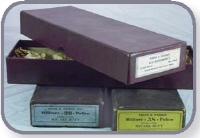
Two-piece Hand Ejector boxes.
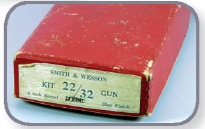
Two-piece red kit gun box.
1946 - 1975 – Two-Piece Boxes: Following WWII, S&W adopted one of the most recognized styles of two-piece boxes. Perhaps finding the previously used hinged lids too expensive or too delicate, this style used a rigid detachable lid, which fit over the bottom portion of the box. In addition, both bottom and lid were covered with a tape-like material that provided additional support to the corners of the box. These boxes are often found with post war N frame revolvers, although medium framed guns with longer barrels have also been recorded. Early ones were sometimes maroon in color, sometimes black. Later ones were more often blue. The early maroon or black boxes had nothing printed on them but would be labeled at the factory when shipped with a gun. Many maroon boxes were used immediately after S&W resumed production following WWII in 1946. Most of the larger N-frame revolvers were shipped in these boxes until the late ‘50s, the only exceptions being those models for which gold boxes were specifically manufactured such as the 1950 Army or the .357 Magnum. The later blue boxes were often used in the ‘60s and ‘70s as shipping boxes for guns repaired at the factory or those N-frame guns sent out with wooden presentation cases. The serial number of the gun is generally written in grease pencil on the bottom of the box.
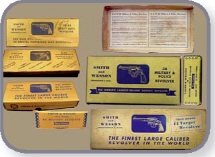
Gold picture boxes. Photos courtesy of Dan Tanko & Old Town Station Dispatch.
1946 - 1965 – Gold Boxes: These were introduced immediately after WWII for some models and gradually spread across most of the S&W product range. They were phased out again in the mid- and late 1950s but were still used until this date on some models. They are, perhaps, the most readily identifiable and collected S&W box. They had the specific model embossed (not merely printed) onto the box lid. The sides and ends were printed with the S&W logo and model information including the guns finish (blue or nickel) and barrel length. The metal corners of both lid and bottom have been found in blue, silver and gold. We have seen it reported elsewhere that the metal corners are coded to the blue or nickel finish of the gun but this is not correct as we have examples of both blue and nickel finished guns in boxes with all three colors. Some guns which it was not planned, at least initially, to manufacture in large numbers did not have their own gold boxes. Instead S&W merely printed a label and stuck it on the end of a suitable box identifying it. An example of this often seen is a K-38 masterpiece box housing a 4” Combat Masterpiece – the box end was labeled, as it was originally printed “6-INCH BARREL.” For gold boxes the serial number of the gun is generally written in grease pencil on the bottom of the box.
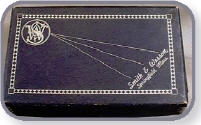
Starburst box. Photo courtesy of Dan Tanko.
1954 - 1959 – Blue Two-Piece Starburst or Sun-Ray Box: This box was introduced to replace the small frame red picture boxes in the very early 50s. As can be seen from the picture a starburst/sun-ray style design spread from the S&W logo on top left of the box lid down to the S&W address on the bottom right. There is a diamond pattern silver line printed around the edge of the lid and the corners were reinforced in blue or black metal. The serial number of the gun is generally written in grease pencil on the bottom of the box.
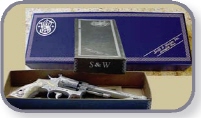
S&W Inc. solid line two piece blue box. Photos by David Ballantyne & Dick Burg.
1957 - 1966 – Blue Two-Piece S&W Box: Possibly introduced to coincide with the advent of Model numbering for the S&W product range. These have the S&W logo top left of the lid, the address on the bottom right side and a solid silver line around the entire edge. The corners are blue metal. The model designation, finish and barrel length are often printed inversely on the box end (blue text showing through a silver printed square). From this point onwards an “Instruction Manual” was placed inside the box giving a complete parts breakdown of the gun and basic operating/safety instructions. Note: Boxes used for nickel guns during this period were gray in color, otherwise identical. The serial number of the gun is generally written in grease pencil on the bottom of the box.

Bangor Punta blue boxes. Photos by Dave Ballantyne.
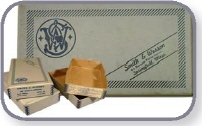
Gray box. Photos courtesy of Dan Tanko & Old Town Station.
1966 - 1985 – Blue Two-Piece “Bangor Punta” Boxes: These came into being after S&W was taken over in the early 1960s. They are largely the same as the previous blue box with the words “of Bangor Punta” or “A Bangor Punta Company” between the Smith & Wesson name and the Springfield, Mass., address printed on the lower right side of the lid. The edge of the box has a dotted silver line printed around it. A slight variation on this box, seen only in the mid 80s, has “Lear Siegler Corp” replacing the Bangor Punta name. This follows the Lear Siegler takeover of Bangor Punta. There is normally a printed label contained the model, finish and barrel length stuck onto the box end. Note – boxes used for nickel guns during this period were gray in color, otherwise identical. The serial number of the gun is generally written in grease pencil on the bottom of the box.

One piece cardboard box. Photo by Dave Ballantyne.
1983 - 1997 – Blue One-Piece Cardboard Containers with Tuck-In Wings: Inside these there was an additional cardboard unit sized to the specific model of gun and with an inset rubber mount for the trigger guard. This was a very solid and easily identifiable unit, cleverly designed for maximum protection of the gun. Boxes for revolvers came in four sizes with a part number stamped on the right inside flap. Part #3392 was for the small J frame, #3393 for small K frame, #3394 was for K and L frames with 6” barrels and #3395 was for the N frame or those handguns with longer barrels. Every box had a printed end label containing information such as serial number, model, finish, barrel length plus a variety of manufacturing or inventory information for S&W’s benefit. Box exteriors are marked repeatedly in large bold letters “REVOLVER” or “PISTOL,” as appropriate to the model.
1997 Onwards – Blue Plastic Containers: Labeled as the previous box and foam filled for maximum protection of the contents. These boxes could also be padlocked if the owner so wished.
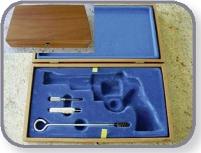
Wood case. Photos by Dave Ballantyne.
Modern Wooden Presentation Cases
For some 20 years, starting in 1960, S&W offered the N-frame revolver range in an optional presentation wood box. After this period S&W continued to offer, and still offers, wooden presentation cases but these were special order items, not optional extras for the gun itself. These later boxes can generally be distinguished as they have the S&W logo “branded” onto the box lid, which the earlier ones did not have.
The wood used for these presentation boxes was light colored, and is often described as mahogany. The corners were dove-tailed and case hinges and clasps were cheaply pressed brass-colored metal. The interior designs varied slightly with four primary types noted, but all were covered with a blue flock material that deteriorated to powder over time. Today cases are often found with a bare interior of black plastic or white Styrofoam. There were various sizes of box offered to match the different N frame barrel lengths. At least four box sizes have been noted but the interior molding was always the exact shape of the gun shipped. Please note that all dates given are approximate.
1960 - 1969 – the “Clam Shell” Case: Styrofoam insets molded to the shape of the specific revolver barrel length. There were also slots molded into the bottom foam for a sight adjustment tool, a swab, and a cleaning rod and brush. The gun faced to the right.
1969 - 1974 – Styrofoam Bottom Insert: Molded to the barrel length of the gun with a foam rubber top insert. Both top and bottom were flock covered. Examples have been found with the gun facing both left and right.
1974 - 1978 – 2 Molded Plastic Inserts: Both covered with blue flock. The bottom insert had the impression of the gun and the tools molded into it. The top insert was flat with a “lip” molded around the edge. The gun faced to the right.
1978 - 1981 – Molded Plastic Bottom with Foam Top Insert: Both flock covered. The bottom plastic insert had the shape of the gun molded into it. There was a separate molded tool compartment with lid and S&W button for lifting purposes. The gun faced to the right.
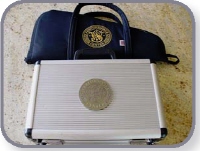
Performance Center hard case and gun rug. Photos by Dave Ballantyne.
Performance Center Cases
In the 1990s S&W introduced a special case for guns sold direct from the Performance Center. These were an aluminum attaché case with carrying handle and two combination locks.
In 2004 these were replaced with a Performance Center gun rug, embroidered with the Performance Center logo. Unfortunately they came as a “one size fits all” and shorter-barreled guns were somewhat lost in them.
SCREWDRIVERS OR “SIGHT ADJUSTMENT TOOLS”
To S&W, the screwdrivers shipped with adjustable or target sights were always “sight adjustment tools.” These have been shipped since before 1900 and have varied greatly in style over that period. At the end of each description we offer a rough guide to internet prices for each. These prices can vary greatly depending on a number of factors but they will give the collector an idea of values in the 2006 market.
1880 - 1930 – One of the earliest recorded was a screwdriver with a hollow brass handle that contained three or four interchangeable blades, believed to have been used from about 1880 to about 1920. Later production had a knurled nut added to hold the blade in place.
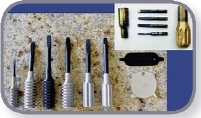
S&W 20th Century screwdrivers, Dave Ballantyne photo. Inset - Early hollow handle brass screwdriver. Old Town Station photo.
1930 - 1941 – Some prewar target revolvers were shipped with a small steel-handled screwdriver. Originals of these have been seen to exchange hands on internet auctions for over $1000. Perhaps as a result of this prices these screwdrivers are being reproduced today using stainless steel handles. The manufacturers have been entirely honest in their aims and descriptions, but unscrupulous resellers may not be. Please ensure the screwdriver you are buying is the genuine article before you purchase.
1940 - 1948 – Nickel knurled-handled screwdriver with black oxide shaft, long tapered end and wider blade. Because these (and the following blue steel version below) are most often seen with post-WWII guns, these are assumed to be postwar screwdrivers. We believe this to be incorrect as these were designed for the first of the micrometer sights fitted to the pre WWII 2nd Model K-22s. Guide price $100, but seldom seen.
1940 - 1958 – Blued steel knurled-handled screwdriver with black oxide shaft, long tapered end and wider blade. Guide price $100.
1958 - 1961 – Aluminum knurled-handled screwdriver with black oxide shaft and long tapered end. Guide price $75.
1961 - 1964 – Aluminum fluted-handled screwdriver long taped end. Guide price $35.
1964 - 1988 – Aluminum fluted-handled screwdriver short taped end. Guide price $10.
1988 - 1991 – Flat steel four-bladed tool for a keychain. Guide price $10.
1991 – onwards: Flat steel two-bladed tool for a keychain. Guide price $5.
CLEANING RODS OR “WIPERS”
From the late 1800s S&W boxes generally contained a brass rod with a flat slotted tip on one end. The other end was curved into a circular handle. In the early 1920s the working end was changed to a threaded hole to accept a screw-in mop, brush, or cleaning jag. Some time before WWII the material was changed to steel. After WWII these cleaning rods were always made of aluminum.
Sometime in the 1980s the style was changed for the first time, eliminating the curved circular handle style. From then on all the rods were of straight design, making them more difficult to pull them through the barrel but, presumably, cheaper to produce.
A subset of this area is collecting special tools made for a particular firearm. One such variation is the tapered swab packaged with the Model 53 Jet and made specifically to fit that gun’s unique bottlenecked chambers. Likewise the cylinder inserts for the same model.
INSTRUCTION MANUALS
These were introduced in 1957 to match the introduction of S&W model numbering. They were normally a four-page, leaflet-style document with a blow-up diagram of the specific model, an accompanying list of part numbers, instructions for use and maintenance, guarantee and so on. Early examples even had prices shown alongside the corresponding item on the parts list.
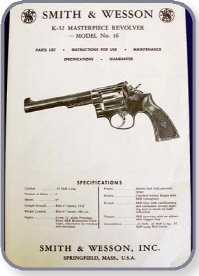
Instruction sheet. Photo by Dave Ballantyne.
The documents were revised regularly and many examples can be found for most S&W models. Most have some form of revision date on them somewhere, often along the bottom of the back page. Be careful not to confuse the document revision date with the statement of liability date – it’s not at all the same thing.
For rarer models (such as the Model 16 or K-32) these pieces of paper can fetch high prices on the internet with over $100 being observed. For a good condition version of a more popular model a price of $15 is a general guide.
SIGHTS
The earliest S&W sights were rather simple affairs. The front sight usually consisted of a semi-circular blade. This was pressed into the barrel rib of tip-up revolvers, and usually pinned in place on most models of top-break revolvers. The rear sight consisted of a notch in the cylinder stop of most tip-ups and a raised portion of the latch on most top-breaks.
Hand Ejector fixed or “service” or “M&P” sights generally consist of a notch rear sight in the topstrap of the frame and either a half round or ramped front sight. Fixed front sights will be found either pinned or otherwise attached in place or forged integral to the barrel. Integral forged front sights are an identifying characteristic of some models.
The first standard production target sights were offered the New Model #3 Target Model, beginning in 1887, although it is reported that they had been available as early as the late 1870s for the standard model New Model #3. Several variations were made, the majority of them consisting of a rear sight attached to the barrel latch holding a separate sight blade that could be adjusted by loosening and retightening the screws, and a Paine type front sight consisting of a long bead on top of a thin flat-topped blade. Another popular front sight was the Winans style, consisting of a rounded blade with an inset bead. An much scarcer alternate rear sight consisted of a thicker drift adjustable rear sight, with more of a triangular than blade profile when viewed from the side.
Adjustable target sights soon were offered as an option on most models, with some models introduced specifically as target models with adjustable sights standard. As handgun target shooting grew in popularity as a sport, a wide range of special sights became available. Some of these could be ordered installed at the factory, and others were installed by gunsmiths.
The Patridge sight was a popular front sight. It provided a tall thin rectangle for the sight picture, with the rear face of the sight blade vertical or undercut to eliminate glare. Perhaps the opposite approach was exhibited by the King reflector front sight, which incorporated a tiny mirror to throw additional light onto the rear face of the front sight blade. Bar inserts into the front sight were popular with some shooters, as were gold, silver, or ivory beads. A flat circle bead insert was a “Call bead,” (named for longtime S&W employee Charles Call) and a hemisphere was a “McGivern bead” (named for famous target & exhibition shooter Ed McGivern).
The front sight configuration that proved most popular and eventually became standard configuration for most revolvers is the ramp style, developed by Frank Baughman for the FBI as the “Baughman Quick-Draw Ramp.” Like the Patridge, this provides a square-topped thin rectangular post front sight picture but has a vertical front face with the rear face consisting of a ramp rising towards the muzzle, usually serrated to reduce glare. The result is a quick, positive sight picture with a front sight that won’t snag on the holster during the draw. A red rectangular insert is sometimes used, and this red ramp (RR) front sight is possibly the most common one used on modern S&W revolvers.
The biggest advancement in rear sights was the development of the micrometer click adjustable rear sight, first introduced on the K22 Masterpiece in 1940. An improved version of this sight is still the standard adjustable or target rear sight today. It is possibly most commonly found with a white outline (WO) on three sides of the blade to increase visibility.
The past decade has brought the increasing popularity of scopes and electronic sights for hunting and competition applications, along with experimentation with laser sights. Provisions for mounting a scope were initially made on some special runs, and now most adjustable sight models are drilled and tapped for scope as standard production. Other recent sight options include interchangeable front sight blades (as on the Classic and Classic DX models), a four-position adjustable front sight, and a Bomar silhouette rear sight.
On autopistols, current production includes the acclaimed Novak Lo-Mount Carry rear sight with its melted snag-resistant triangular profile on many fixed sight models, or protective wings on most adjustable sights. The three dot sighting system is popular, with a white dot inlaid in the front sight and in each side of the rear sight. Night sights are offered on some models. These usually consist of glow-in-the-dark tritium inserts in front and rear sights, usually three-dot or dot-and-bar configurations.
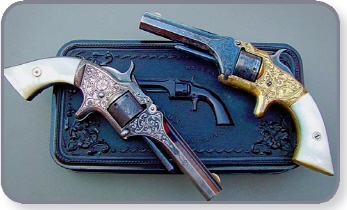
Consecutive pair factory engraved Model Ones. Old Town Station Dispatch photo.
ENGRAVING
In many cases, engraved guns are valued more as art than as collectible guns. As in art, an authentic old master is worth a lot of money, while you may have trouble giving away the firearm equivalent of a sofa-sized starving artist parking lot sale rendition of Elvis at the Last Supper on black velvet.
Factors to consider when evaluating an engraved gun:
Factory engraved: Factory engraving will always enhance the value of the gun. To be worth full value, a factory engraved gun should be confirmed by a factory letter.
Extent of coverage: Currently, the factory catalogs four levels of coverage – Master, A, B, or C - price varying with extent of coverage and size and type of gun. These are:
Master – 100% coverage.
A – 75% coverage
B – 50% coverage
C – 25% coverage
A few years ago, the factory coverages were reportedly defined as: A - full coverage, B - 2/3 coverage, and C - 1/3 coverage.
In looking at auction reports of modern factory engraved S&Ws, one may note that the auctioned price of a recent factory engraved gun will often be less than the cost of a similar new gun plus the cost of having the factory engrave it. We suspect there are two factors at work here:
It seems that modern engraved guns have fallen a bit out of favor in recent years (which also means that this era could represent a buying opportunity for collectors who do like engraved guns).
The buyer who wants an engraved gun may prefer to order the exact model and engraving pattern which he wants, rather than buy a pre-engraved gun. An exception to this seeming lessening of interest may be seen where a particular gun is attributed to a specific factory engraver, or on out-of-production models or variations where it is known that only a small number of guns were factory engraved. In each of these two situations, a factory engraved gun may bring more than the sum of gun cost plus engraving cost. Earlier factory engraving coverage was designated by a number. A turn of the century S&W catalog illustrates seven styles of engraving, labels “Style No. 1” through “Style No. 7.” It appears as if extent of coverage may have increased as the numbers get larger – No. 1 is rather sparse, and No. 7 quite extensive.
Period of engraving: Is the period of the engraving the same as the period of usage of the gun? This is especially important on non-factory engraved guns. Almost any period engraving can add some interest to an older gun, even if relatively crudely done. This seems particularly true on guns from the 1800s, where an old pawnshop engraving job can add a colorful air to an old shooting iron. Modern engraving on an old gun is very much a matter of taste. Even if beautifully done, it tends to turn off many collectors. Some individuals may want to own a showy older gun without shelling out the big bucks a high condition period engraved piece would bring, and may well pay a premium for a tarted-up old gun. Mediocre or poor modern engraving, or worse yet, modern engraving fraudulently passed off as older engraving, will nearly always diminish the value of an antique gun.
Hand cut, rotograved, or laser etched: Hand cut generally requires the most skill and time and brings the greatest premium. Beautiful engraving can also be done with modern electric engraving tools, but may suffer in detail and will not bring as much. Laser etched designs are valued more as a standard variation of a particular model than as an individual piece of art.
Artistic quality of the engraving: Two factors to consider here are the overall artistic quality of the layout and the skill with which it has been executed, all of which brings us to:
The engraver and style of engraving: Pieces that can be definitively attributed to one of the great master engravers will always bring a premium price. However, this is regrettably seldom a sure thing, as engravers seldom signed their work, and the specific engraver is not always reflected in the factory records. There are a handful of individuals who MAY be qualified to tentatively identify an engraver by inspecting his work. Sometimes a specific piece may be identified from the rubbings done by the original engraver and kept in his pattern book. Lacking one of these types of confirmation, it is usually safest to refer to engraving as being in the style of a particular engraver rather than making specific attribution. Also remember that most highly skilled engravers could carve in a number of different styles, if the customer wished.
Neither of the authors profess to be anything resembling an expert on firearms engraving. However, if the reader will promise to take it with a grain of salt, we will offer the following comments on engravers and styles of special note, in order to give the prospective student of gun art a starting place:
Nimschke: L. D. Nimschke is probably the best known of the great engravers. He is most commonly associated with a large profuse floral scroll style, also sometimes called New York style engraving. Whether Nimschke’s style was widely imitated or he was the master of this particular popular style is open to debate. Probably a little of both. Nimschke was an independent artist rather than a factory employee, and worked on many makes of guns. Often he would engrave for a distributor rather than the manufacturer. His pattern book has been published in R. L. Wilson’s L. D. Nimschke, Firearms Engraver.
Gustave Young: Young was a master engraver for Colt before he was hired as in-house factory engraver for S&W in 1867. His hand created some of the most exquisitely decorated Smith &Wessons ever made. His style is typically thought of as utilizing smaller vine scroll patterns than most New York style engraving, with his scrolls often having nearly perfectly circular endings.
Oscar, Eugene, and Robert Young: Gustave’s sons, they worked with and succeeded him as S&W factory engravers. Their skill approached that of their father, and their styles were similar. Oscar was with the factory full-time until 1916.
Paul Piquette: Recent S&W master engraver turned out some beautiful work.
Germanic vine scroll: An open vine style of engraving.
Rose pattern: Rose and other floral patterns; usually more literal than other scroll styles.
English scroll: Tight, almost circular scroll patterns.
Inhabited scroll: Sometimes, small fanciful creatures unlike any found in nature will be found inhabiting the scroll work. This has been attributed by some to the Mideastern origins of many engraving patterns and the ancient Moslem proscription of making images of actual creatures as created by Allah.
Panel scenes: In general, representational art is rather scarce in firearms engraving, especially older engraving. A few old S&Ws will be found with panel scenes on them, however.
Tiffany: Noted New York jewelers Tiffany created a very few beautifully decorated firearms by an etching process rather than engraving. These have a distinctive appearance and are sometimes combined with striking ornate Tiffany grips. Modern replicas of this century-old process have been reported, and a buyer contemplating paying a large sum for a Tiffany etched piece would do well to get an expert opinion.
Punch dot engraving: A style of engraving done by punching dots into the metal rather than cutting the metal with chisels. This was not a S&W factory style, and is most commonly associated with Merwin-Hulbert revolver engraving. However, it is sometimes found as aftermarket engraving on nineteenth-century S&W revolvers. Punch dot engraved S&Ws generally bring less than quality cut engraving, but can be colorful and evocative of the era.
Gold: Gold wash (a very thin gold layer sometimes used for broad highlights, such as cylinder flutes), gold plate (a thicker layer of gold, generally applied to the entire gun or a major component, such as the cylinder), and gold inlay (gold wire, figures, or other decoration added on to the engraved pattern) will add value to engraving.
Lasersmith: A process introduced in 1989 for laser etching images on metal. It is very interesting to see the blue laser light as it just cuts (melts) its way very rapidly and efficiently into the metal, especially the alloy frames. S&W offers some standard laser engraved patterns at a very reasonable cost. Those customers wishing to have certain laser engraving removed (such as “LadySmith” on their carry piece) may call the customer support center and request it to be bead-blasted to remove some lasering. The authors tried it and the work was excellent, as the removal of “LadySmith” on a 65LS for a certain conceal carry piece was never noticeable.
FACTORY ENGRAVERS
Former S&W Master Engraver Paul Piquette was kind enough to provide the following comments and list of S&W factory engravers. (The authors’ additions to Mr. Piquette’s comments are in parentheses):
“This list includes some outside vendors. The list of actual individuals would probably be larger except that records from the vendors such as Tiffany, American Engravers, and L. D. Nimschke didn’t indicate the actual engravers name. However, this is still a comprehensive list.
“Several of these fine artisans worked both as factory and as commissioned engravers, especially in the 1850s. The Youngs were the first actual factory engravers. The period from 1960-1974 saw many engravers come and go. They worked either as apprentices under Russell Smith or had some experience as engravers. At least thirteen came and went, some to continue their engraving work independently or for other firms.”
S&W Engravers:
• Richard Bates Inshaw
• F. W. Martin * (His work found especially on Model One First and Second Issues)
• S. T. Merritt
• E. A. Timme
• P. S. Yendell
• L. D. Nimschke*
• Gustave Young*
• Oscar Young*
• Eugene Young*
• Tiffany Jewelers*
• Harry Jarvis* (c. 1903-1953)
• Leon Goodyear* (c. 1920s and 1930s)
• R. J. Kornbrath*
• Alvin White*
• Russell Smith*
• Virginia LeBlanc (first woman S&W engraver)
• Siefried Rentszchke
• John Anderson
• Gregg Duplaise
• Dave Klemper (Worked at S&W twice - late 1960s and early 1980s)
• Mike Kapinos
• Bryson Gwinnell (Later engraved for Colt)
• Bob Burt
• Steve Kamyk (Currently engraving for Colt)
• Mike Grovronwich
• Tom Freyburger
• Dominqos Joaquin*
• Denise Thirion (of American Engravers, R. L. Wilson)
• John Pease
• Paul Piquette*
Authors’ Note: It appears that this list may be in very general chronological order. The authors have included an asterisk (*) after those names that seem to be most well-known among S&W collectors.
Engraving Today
Antonio A. Miele is the current head of the S&W Engraving Department. In addition to the four levels of engraving coverage mentioned previously, S&W offers a number of special decoration techniques, including:
• Raised or flush inlay; semi-relief or deep relief modeling. Inlay elements may include bands, borders, lettering or sculpture.
• Inlay materials include precious metals, diamonds, rubies, onyx, jade, other precious and semi-precious stones, and ivory.
• Beaded, stippled or lined backgrounds; shading varying from simple to intricate
• Entire gun or highlighted areas polished bright.
• Finish in matte, high bright, differential, blue, gold plating, and nickel plating.
Engraved S&W Photo Gallery
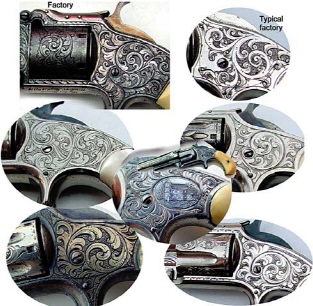
Details of period engraved tip-ups. Top left is factory engraved. Top right is factory engraved with the typical tight scrollwork. Center includes a cylinder scene.
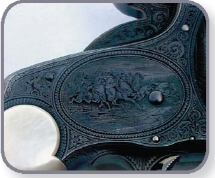
Detailed cylinder scene on a Young factory engraved New Model No. 3. Supica photo.
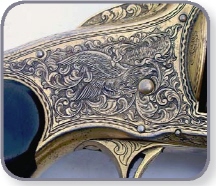
Eagle and scroll on a Russian Model, Supica photo.
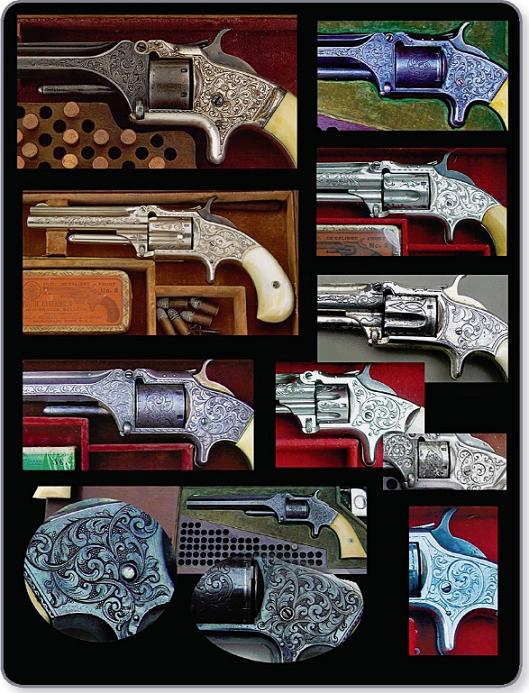
Period engraved tip-up revolvers. Top two in the left column are from the David Carroll collection from photos by Paul Goodwin. Others are from Old Town Station Dispatch and ArmsBid.com.
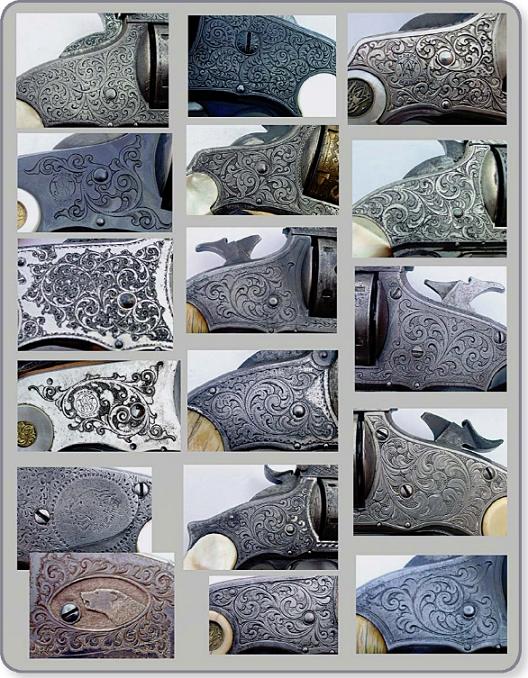
Details of period engraving on Model Threes. 1 through 4 show typical Young family factory engraving. 1 is a special exhibition gun. 5 shows simple punch dot engraving, seldom seen on S&Ws. 6 is unusual style engraving on a Schofield. 7 & 8 have been attributed to master engraver L.D. Nimschke, 7 in an English scroll pattern unusual for him, and 8 in the typical large flowing Nimschke scroll. 9 thru 11, and 16 & 17, are similar scroll engraving, often refered to as “New York” or “Nimschke style” engraving (with the former designation generally preferred, as it does not suggest an unproved attribution). 12 & 13 show a deeper cut scroll with heavier relief. 14 & 15 show relatively low relief engraving. Supica photo.
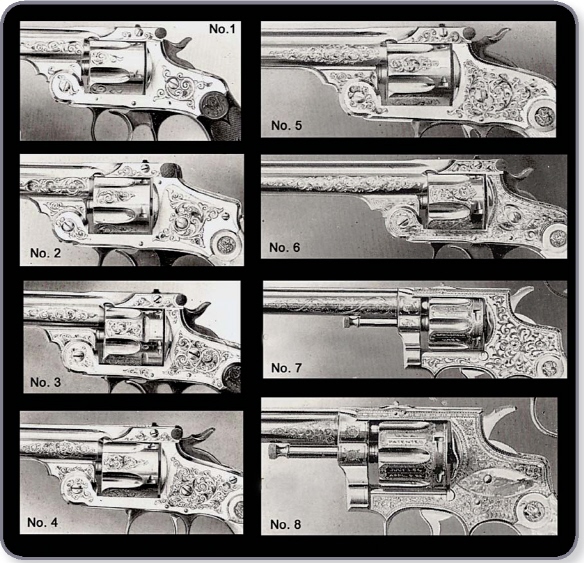
The factory offered various amounts of coverage, with increasing amounts and complexity of engraving designated by increasing numbers, as illustrated in these pictures from a late 1890s catalog.
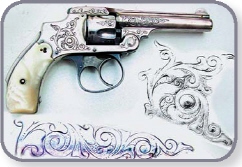
Factory engraved Safety Hammerless with relatively sparse coverage. ArmsBid.com photo.
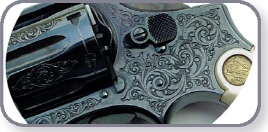
Oscar Young factory engraving, Old Town Station photo.
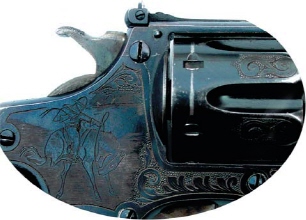
Gough engraving, ArmchairGunShow.com photo.
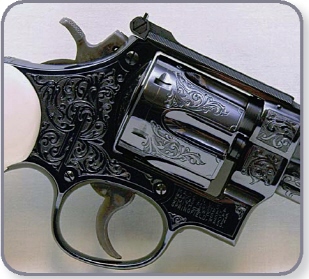
Harry Jarvis engraving, early 1950s, Photo courtesy of Bill Cross.
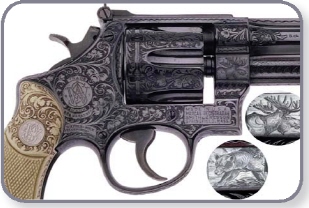
Siegfried Werner of Waff en-bock engraving on a Model 27 for D. Wesson, early 1950s. Michael Kennelly collection. Photo by Paul Goodwin.
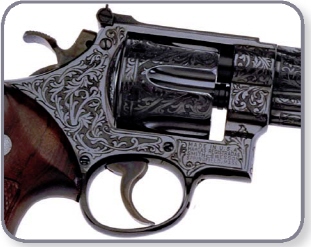
Harry Jarvis engraving, ca. 1953. Michael Kennelly collection, Paul Goodwin photo.
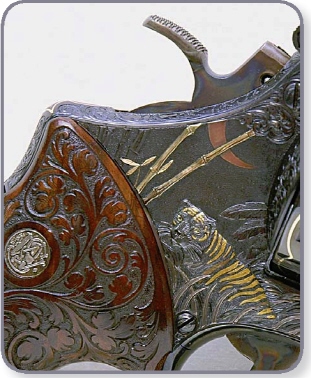
Alvin White engraving, ca. 1956. Photo courtesy of Bill Cross.
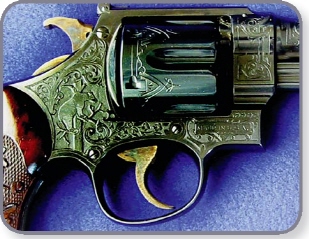
Russell Smith engraving, ca. 1956. Photo courtesy of David Ballantyne.
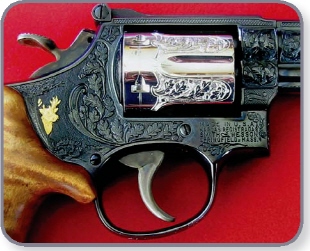
Russell Smith engraving, c. 1956. Photo courtesy of David Ballantyne.
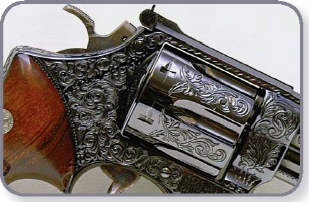
Russell Smith engraving, c. 1956. Photo courtesy of Bill Cross.
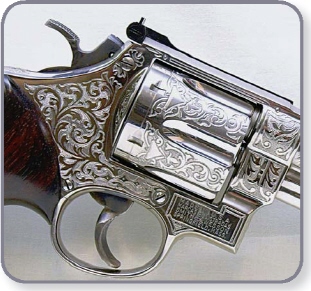
Siegfried Rentzchke class A factory engraving, c. 1956. Photo courtesy of Bill Cross.
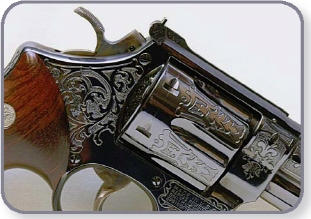
Virginia LeBlanc engraving, c. 1957. Photo courtesy of Bill Cross.
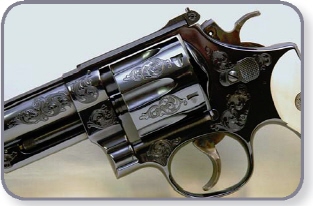
Paul Piquette engraving, c. early 1980s. Photo courtesy of Bill Cross.

Dave Misiaszek banknote style engraving, c. 2001. Photo courtesy of Bill Cross.

Wayne DeAngelo engraving, c. 2001. Photo courtesy of Bill Cross.
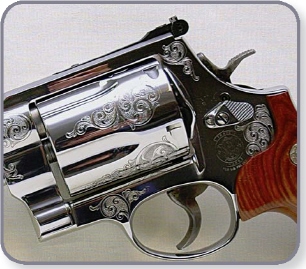
John Pease factory contract engraving, c. 2003. Photo courtesy of Bill Cross.
AUCTION BLOCK — ENGAVED GUNS
Since our last edition, there have been a number of national level auctions which sold a significant number of early engraved S&Ws out of major collections, the results of which may help illustrate the values of engraved S&Ws.
The auctions reported below took place from 2002 through early 2006. The prices realized illustrate both the increasing value of engraved S&Ws, and especially the wide variation in values depending on such factors as origin of engraving (factory or other), condition, coverage, artistic value, and rarity. All attributions of engraving and descriptions of condition are highly abbreviated exerpts the auction catalogs (see note at end of this section).
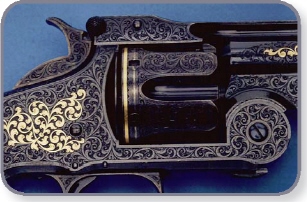
One of the finest engraved S&Ws. American Model engraved by Gustave Young with gold inly. Photo courtesy of John Gangel, Little John’s Auction.
The most expensive engraved Smith and Wessons we can recall selling at public auction were sold in 2002 by Greg Martin Auctions. Both were pictured in the color section of the 2nd edition of Standard Catalog of S&W. They are the Tiffany-engraved ivory and silver-gripped .44 DA and Gen. Grant’s gold-inlaid Young-engraved Model 1-1/2. The former reportedly sold for $302,000 and the latter $548,000.
In March of 2006, James D. Julia, Inc. auctioned four of the finest known engraved S&Ws. Two were a consecutive pair of early 2nd Model Americans, each elaborately engraved with full coverage by Gustave Young, and each with pearl grips and in excellent condition. One had a gold plated cylinder and frame with a blue barrel and the other blue overall with contrasting inlaid gold foliate arabesques (the gun prominently pictured in the color section of the 2nd edition of this book). These sold for $172,500 and $195,000. The following lot was a consecutive pair of Gustave Young-engraved Model One Second Issues, with identical foliate engraving with wolf’s head and gold frames with blued gold-line-inlaid cylinders and barrels, in exceptional condition, inscribed to John A. Rice. The pair sold for $207,000. These and others in this sale have special interest as some of the best S&Ws ever sold, and also as guns that have been previously sold at other auctions within recent years. These and other engraved Smiths from the March 2006 Julia sale are listed in the following table:
JULIA, 3/06 AUCTION
| MODEL | DESCRIPTION | PRICE |
| 2nd American | Gustave Young engraved, gold cyl. & frame. (previously auctioned by Greg Martin for $179,200; Fall 2002) |
$172,500 |
| 2nd American | Gustave Young engraved, blue with gold arabesque inlay (previously auctioned by Greg Martin for $179,200; Fall 2002) (previously auctioned by Little John’s for $187,000, 1993) |
$195,000 |
| Pair 1st, 2nds | Gustave Young engraved with gold frame, inscribed to Rice. (previously auctioned by Julia for $184,000; Fall 2004) (previously auctioned by Greg Martin for $168,000; Summer 2002) |
$207,000 |
| Pair .44 DA Frontiers | Cased; Gustave Young style engraving, very fine & 85% (previously auctioned by Greg Martin for $44,800; Fall 2002) |
$42,250 |
| Pair of New Model #3s | Cased; presentation; New York style engraved, probably Nimschke, fine to very fine | $28,750 |
| 2nd Model American | Gustave Young engraving, very fine...90% | $12,938 |
| 2nd Model American | Nimschke style, good to very good; no orig. finish | $3,738 |
| New Model #3 Target | Gustave Young style engraving, very fine...88-90%. (Estimated $13,500 to $17,500) | $ 0* |
| 2nd American Rimfire | Appears to be factory engraving, carved ivory silver capped grips; about good...no orig. finish. | $5,750 |
| Model 1, 3rd issue | Samuel J. Hoggson engraved, bird-dog vignettes; very fine to extremely fine. | $5,750 |
| Model 1, 2nd issue | Foliate arabesque engraved, carved ivories; very fine. | $2,358 |
| Model 1, 3rd issue | Factory engraved, very fine. | $3,220 |
| Model 1-1/2, New Model | New York style engraved, very fine, 92-93% | $1,150 |
| .38 SA, 3rd Model | Factory engraved; extremely fine, 97-98%. (Estimate $3,500-4,500) | $ 0* |
* These two lots were reported as “$0” on the auctioneer’s prices realized sheet. Significance unknown, but it is a fairly common practice to list “No-sales” as “$0” on prices realized. This may occur for a variety of reasons, most often when an item fails to reach the “reserve price,” or the minimum bid at which the auctioneer is authorized to sell the piece. Most auctioneers have a policy of not accepting reserves which are higher than the low end of the pre-sale price estimate published in the catalog. If so, this is a fair and reasonable way of handling the reporting of reserve no-sales.
A notable public sale of a larger number of high condition finely engraved early Smith & Wessons occurred in September of 2005 when Amoskeag Auction Company auctioned the estate collection of the late Gary Garbrecht, who was certainly one of the pre-eminent S&W collectors in the world. He was noted for collecting only the finest condition arms, and pursuing the best known engraved guns. His collection included a number of highly decorated arms prepared especially for S&W’s famous 1893 Columbian Exhibition display, showcasing their finest engraving. The table below reports the sales price, including buyer’s premium, of most of the engraved pieces from the Garbrecht collection auction.
AMOSKEAG, 9/05 AUCTION - COLUMBIAN EXHIBITION GUNS C. 1893, MOST WITH PEARL MEDALLION GRIPS.
| MODEL | DESCRIPTION | PRICE |
| New Model #3, 4"barrel | Gustave Young factory engraved, 98%, Columbian Exhib. | $86,250 |
| New Model #3, 5" barrel | Gustave Young factory engraved, 95%, Columbian Exhib. | $51,750 |
| .44 DA, 1st Model | Columbian Exhib. Engraved, 99% | $63,250 |
| .38 SA,3rd Model | Eugene Young factory engraved, 99%, Columbian Exhib. | $31,625 |
| .38 DA, 3rd Model | Factory engraved, probably Columbian Exhib., 99% | $31,625 |
| 1st Model Single Shot | Oscar Young factory engraved, prob. Col. Exhib., 98% | $63,250 |
| 1st Model Single Shot | Factory engraved, 98%, Columbian Exhib. | $43,125 |
Other engraved early S&Ws from the Garbrecht collection sold at the same auction for the following amounts.
AMOSKEAG 9/05 - OTHER ENGRAVED SMITHS
| MODEL | DESCRIPTION | PRICE |
| Model 1, 2nd issue | Factory engraved, gutta percha case, superb...97% | $19,550 |
| .32 DA, 4th Model | Factory engraved by Oscar Young, No. 6 style, 95% | $13,800 |
| No. 2 Army | Nimschke engraved, 90% | $11,500 |
| 1st Model Russian | Nimschke engraved, 95% | $51,750 |
| .32 DA, 2nd Model | Factory engraved, 97-98% | $2,588 |
| 2nd Model American | New York engraved, 95% | $10,925 |
| 3rd Model Single Shot | Kornbrath engraved, 98% “one of the finest engraved S&W Single Shot Pistols ever completed.” | $57,500 |
| Model 1,2ndd issue. | Factory engraved, gutta percha case, very good ... 90 to 95% | $8,050 |
| .320 Revolving rifle | Gustave Young, one of only two known factory engraved revolving rifles, case & accessories, excellent ... 95% | $69,000 |
| Model 1-1/2, New Model | Factory engraved; wood case, ivory grips; 95% | $14,950 |
| Model 1, 3rd Issue | Factory engraved & cased, ivory grips, 98% | $7,475 |
| .38 SA, 2nd Model | Nimschke engraved, 97% | $4,025 |
| .32 Safety H’less, 1st Md. | Young factory engraved, 93% | $12,075 |
| .32 HE, 3rd Model | Factory engraved, 99% | $4,600 |
| No. 2 Army | Factory engraved, wood case, 80% | $9,500 |
| Cased pair K38 Masterpiece | Russell Smith factory engraved, one B, one A+, both 99% | $8,625 |
| K22 & Model 19 | Alvin White engraved & cased outside factory | $9,775 |
| Model 1-1/2, New Model | New York engraved, carved ivories, pipe cased | $16,100 |
| New Model #3 Target | Factory engraved, 50% | $9,200 |
| .32 HE, 1903 5th Chng. | Factory engraved, presentation inscribed. 93% | $1,150 |
| New Model #3 | Factory engraved, dealer cased, 98% | $5,750 |
| Registered Magnum | Custom floral engraving; 99% quality blue | $3,105 |
| Registered Magnum | Jaeger attributed floral scroll; 99% | $6,900 |
| Registered Magnum | Floral scroll, gold bear inlay, steerhead pearls, 99% | $6,235 |
| Registered Magnum | Alvin White engraved, Roper grips, 99% | $12,650 |
| Registered Magnum | Alvin White, rural scene, animal inlays, gold line borders, 98% | $9,775 |
| Registered Magnum | Light scroll engraved, cowboy & eagle gold inlaid, not reblued afer engraving, 98% | $4,025 |
| Centennial | Factory engraved; 95% gold wash | $2,070 |
| .32 DA, 4th Model | Factory engraved, very minty, 98% | $2,300 |
| .32 Safety Hammerless, 1st | Factory engraved, Oscar Young, 98% | $3,738 |
| .38 DA, 2nd Model | New York engraved, 95% | $1,265 |
| .38 SA, 2nd Model | New York engraving, box, 99% | $2,185 |
| .38 DA, 3rd Model | New York engraving, 95-97% | $1,035 |
As possibly the largest volume specialty firearms auction house, Rock Island Auction’s sales often include at least some engraved Smiths. A recent example from December, 2005, illustrates the values of early engraved pieces in a wide range of condition and engraving styles:
ROCK ISLAND AUCTION 12/05
| MODEL | DESCRIPTION | PRICE |
| Model 1, 3rd issue | New York Style engraving, near excellent, approx. 80% | $1,380 |
| Model 1, 3rd issue | Engraved, fine, 70% | $1,380 |
| .32 SA | Nimschke style, little coverage, near mint, silver | $1,380 |
| .38 SA,2nd Model | “an attempt to engrave in Gustave Young’s style,” refurbished, cold blue w/ gray patina, scarce 6” barrel. | $1,035 |
| Model 1, 3rd issue | Factory engraved, presentation inscribed, very good plus, grey. | $1,495 |
| Model 1, 2nd issue | New York style engraved, very good plus, 40% | $863 |
| New Model #3 | New York style period engraved; 95% | $9,200 |
| New Model #3, Target | New York style engraving; excellent as period refinished, 95% | $3,163 |
| .32 DA | Cased, gold plated, Gustave Young engraved; period regilted | $8.050 |
| .38 DA | Light engraving, inscribed; replated, 75% | $748 |
| 2nd Model Single Shot | Pope barrel, New York style engraved; excellent as customized, 95% | $7,475 |
| 2nd Model Single Shot | Custom engraved, “not a recognized style”; reblue | $1,265 |
| 1st Model Single Shot | Light custom engraving, refinished, replaced grips | $431 |
A couple years earlier, in October, 2003, co-author Jim Supica’s Old Town Station auctioned the estate collection of a major S&W collector, including a number of early engraved pieces. Prices realized for that sale on engraved S&Ws:
SUPICA OLD TOWN STATION, 10/03 AUCTION
| MODEL | DESCRIPTIONS | PRICE |
| Model 1, 2nd issue | Factory special engraved, gilded frame, excellent...90% | $8,800 |
| Model 1, 2nd issue | Factory special engraved, consec. s/n to abv., excellent | $5,225 |
| Model 1, 3rd issue | Period foliate scroll engraved, about excellent | $935 |
| Model 1, 3rd issue | Factory engraved, cased w/ ammo box, excellent to fine | $2,420 |
| Model 1, 3rd issue | Engraved & cased; about excellent | $1,650 |
| Model 1-1/2, Old Model | Old style engraving & gold inlay; fine to excellent. | $2,090 |
| Model 1-1/2, Old Model | New York/Nimschke style engraved, cased; very good | $1,650 |
| Model 1-1/2, New Model | Period foliate scroll engraved, cased; excellent plus | $2,420 |
| Model 1-1/2, New Model | Period scroll & geometric pattern engraved, panel scene; fine plus | $1,320 |
| Model 1-1/2, New Model | Engraved, cased with ctg. box; excellent plus...about 100% | $2,650 |
| Model 1-1/2, New Model | Factory engraved Young style, cased; excellent...98% | $4,675 |
| Model 2 Old Army | Appears to be period engraved; carved ivories; excellent as restored. | $3,300 |
| Model 2 Old Army | Period New York engraved, cased; Fine to excellent, 80% | $6,050 |
| Model 2 Old Army | Factory engraved, presentation, cased; excellent | $8,250 |
| 2nd Model American | Lightly cut scroll engraving of unknown vintage; good. | $3,080 |
| 2nd Model American Rimfire | New York engraved, pearl grips, cased; excellent | $35,750 |
| 3rd Model Russian | Period New York engraved, carved ivories, excellent...95%+ | $9,350 |
| New Model #3 | Engraving of more recent vintage; refinished | $2,090 |
| .32 SA | Period engraved New York style; excellent...98% | $1,020 |
| .38 SA, 2nd Model | New York style engraving, cased; fine...70% | $1,155 |
| .38 DA, 3rd Model | Deep scroll engraving, uncertain vintage; 95% | $1,375 |
| .32 Safety Hammerless, 1st | Factory engraved, excellent...98% | $1,100 |
| .38 HE Target, Model 1902 | Oscar Young factory engraved, excellent plus...98-99% | $14,025 |
| .38/200 British Service | English scroll engraved, carved ivories, excellent as reworked | $990 |
| Model 60 Chiefs Stainless | Neil Hartliep engraved, excellent plus | $1,480 |
In March 2003, James D. Julia auctioned a large S&W collection that included a significant number of nice early engraved S&Ws. The results of that sale probably reflect both the increase in value of engraved guns in a couple years period, and the premium paid for the highest condition examples vs. those in lesser condition grades:
JULIA, 3/03 AUCTION
| MODEL | DESCRIPTION | PRICE |
| 3rd Model Russian | New York style foliate arabesque engraving, very good...50-60% | $4,888 |
| 2nd Model Schofield | New York style engraving, inscribed, good...20-25% | $6,210 |
| New Model #3 | New York style engraving, good...20-25% | $2,875 |
| Transition American | New York style engraving, very good...90% silver, 95% restored case colors | $3,163 |
| Model 1-1/2, Old Model | New York style engraving, fine...refinished | $1,725 |
| Model 1-1/2, New Model | New York style engraving, about good | $633 |
| .38 SA, 3rd Model | Appears to be factory engraved, fine as factory refinished | $1,898 |
| .38 DA,3rd Model | Rare etched engraved, very fine | $690 |
| .32 Safety Hammerless, 2nd | 2" barrel, factory engraved, very fine | $3,795 |
| .38 Safety Hammerless, 4th | Appears to be factory engraved, fine...95-97% | $1,265 |
| .38 Safety Hammerless, 3rd | 2-1/4" barrel, NY style engraving, extremely fine | $2,386 |
| 3rd Model Russian | New York style engraving, very good | $3,393 |
| DA, 1st Model | .38-44 cal., engraving probably not factory, very good to exc. | $2,128 |
| New Model #3 | 5" barrel, factory engraved, good condition | $3,392 |
| 2nd Model Russian | Modest quality engraving, fine...30-40% | $3,163 |
| DA Frontier | .38 WCF, engraving reminiscent of Nimschke but not as good, fine to excellent | $2,358 |
The results of the above auctions are instructive in evaluating engraved S&Ws. The brief descriptions above are certainly inadequate to convey the quality of the guns mentioned, and the serious student of engraving would do well to acquire copies of the auction catalogs for closer study.
It is obvious that the great masterworks of S&W’s finest engravers are highly valuable works of art, especially when combined with high condition, a desirable model, and special history. However, the other engraved gun prices in these auctions also help to understand the market.
PRICING ENGRAVED S&WS
The following is offered with some hesitancy, in hopes that the collector will view it with healthy skepticism, but perhaps be able to use it to begin to build his own method of assessing the value of older engraved S&Ws.
• Simple factory engraving on a fairly common model may bring about double what a comparable condition non-engraved specimen would bring.
• Well-done simple non-factory period engraving may bring a lesser premium, perhaps 25% to 100%.
• As the extent of coverage and quality of engraving increases, the premium increases.
• Premium will be paid higher for a known, well-respected engraver’s work.
• Factory engraving on models that were rarely engraved will bring a higher premium.
• Poorly done engraving or engraving that is not contemporary to the gun may actually reduce the value of the gun. This would be especially true on rare variations.
EVALUATING CONDITION
CONDITION RATINGS IN THIS BOOK
IMPORTANT NOTE: To effectively use the price guide portions of this book, you must understand the definitions of the terms used to describe the condition of a gun.
Generally, this book uses condition grades based on those established by the NRA, with slight modifications and expansion to fit the subject matter of this book. If you are familiar with those NRA ratings, you may generally use them with confidence.
Note that the NRA has two sets of condition definitions, applying separate definitions to antique guns than are used for modern guns. We have slightly modified this into more of a sliding scale based on the age of the gun. A full discussion of how our condition terms differ from the NRA’s definitions is included later in this chapter.
It is important to note that these terms do NOT have the same definitions in this book as are published in our sister publication, Standard Catalog of Firearms. This is most significant in understanding the condition of antique guns. Standard Catalog of Firearms condition definitions for antique guns are much more stringent than those standardized by the NRA and those used in this book.
DEFINITIONS OF CONDITION TERMS USED IN THIS BOOK
AS NEW IN BOX (ANIB) or AS NEW: In the same condition as when the gun left the factory, with accompanying box, literature, and accessories. This is important to note, as older boxes may have substantial value in themselves. Purists will want the box to be the original box which that particular gun was shipped in (serial number was often penciled on the bottom or marked on the end of the box by the factory). The value of the correct box should be added to the “As New” value if it is included, or deducted from the “ANIB” value if not included. On older guns, or those with rare boxes, the condition of the box may affect the value.
As to the condition of the gun itself, the it must be as it was when new from the factory. Comparable terms expressing the same gun condition when not accompanied by box might include “AS NEW,” “MINT,” “PERFECT,” or “100%.” Even if the gun has never been fired, if the action has been worked to the extent that wear is visible, the value may be less than “ANIB” or “AS NEW” to a collector who is particular about condition. For example, the faint drag line that appears on the cylinder of a revolver that has been “dry-fired” a few times will reduce the value to less than “AS NEW” for a condition purist. This sort of general “shop-wear” to an otherwise new, current production gun will not usually matter to a buyer purchasing the gun to shoot. It rapidly becomes more important to a “condition collector” who wants a truly pristine example of an out-of-production piece.
“Unfired” is a term that is sometimes used in discussing an ANIB gun. With a S&W, this term is not technically correct, since the gun has usually been test-fired at the factory. Perhaps the most that could be accurately stated in this regard is “Appears unfired since factory.” Further, it should be remembered that guns that are indeed unfired since the factory may not be ANIB. Older guns which have never been fired by an owner may show aging or flaking of finish, or even rust or pitting from poor storage.
An ANIB condition S&W may actually be considered by some to have less than “100% original finish,” since the action is worked during assembly and fitting. Many would contend that a properly timed S&W left the factory with a slight cylinder drag line from such manipulation.
“As New” is an absolute term, with no sliding scale based on age. Generally ANIB condition is extremely rare in antique guns, but an antique gun that is ANIB or AS NEW will bring substantial premium over Antique Excellent condition -sometimes bringing double or more what the same model would bring in Excellent condition. This wide range in values between ANIB and Excellent in older guns has led us to introduce a new condition classification with this Edition, to wit:
EXCELLENT PLUS (EXC+): An older gun that retains 98% to 99%+ original finish, but is in less than As New condition. The gun may show slight signs of usage or wear, but should otherwise be perfect and original in all respects. This classification has been introduced to cover those situations with antique and pre-WWII guns where ANIB condition examples may be virtually non-existant, but a large premium will be paid for the highest condition examples, well in excess of what the same model would bring at the lower end of the Antique Excellent condition range.
EXCELLENT (EXC): All original parts and configuration. For modern guns, nearly new condition, with only slight finish wear at muzzle or sharp edges. For antique guns, sharp markings, unmarred grips, fine bore. Also, excellent guns should generally exhibit at least the following percentages of original finish, depending on production era and type of finish:
| ERA | BLUED | NICKEL |
| Post-1945 | 98% | 99+% |
| 1920 - 1945 | 95% | 98% |
| 1890 - 1920: | 90% | 95% |
| 1865-1890 | 85% | 90% |
| Pre-1865 | 80% | 85% |
For comparison, the definitions require that NRA Modern Exc. have “bluing perfect, except at muzzle or sharp edges” and elsewhere specify “95-99% original finish.” NRA Antique Exc. retains “over 80% original finish.”
Stainless steel and synthetics: Due to the durability of the finish, most used stainless steel guns are found in Excellent to Very Good condition so long as they are unmodified and in perfect working order. Similar considerations apply to polymer or other synthetic frame material.
FINE: This condition rating applies primarily to older and antique guns. All original parts and configuration, or possibly a very minor alteration from original configuration that was made during the period of use (fancy grips added, sight configuration changed slightly, etc.). Sharp markings, only minor grip blemishes, good bore. Minor replaced parts may be acceptable on antique guns but will affect value. Also, at least the following percentage of original finish by production era & type of finish:
| ERA | BLUED | NICKEL |
| 1920 - 1945 | 90% | 95% |
| 1890 - 1920 | 70% | 80% |
| 1865 - 1890 | 50% | 70% |
| Pre-1865 | 30% | 50% |
For comparison, there is no NRA standard for “Modern Fine.” NRA “Antique Fine” requires “over 30% original finish.”
Factory refinish – A factory refinished antique S&W with 98% of the refinish remaining, which was in excellent condition before refinishing (i.e., sharp markings, no pitting remaining under refinish) may approach Fine in value.
VERY GOOD (VG): All original major parts. For modern guns, must be in perfect working order, no corrosion or pitting, minor scratches only. For antique guns, smooth metal and sharp edges, clear markings. Mismatched parts from the same model, or minor replaced parts may be acceptable on older guns, but will effect value. Also, at least the following percentage of original finish depending on production era. (At this condition level, the difference between blue and nickel finish required is not significant as to rating condition.)
| ERA | FINISH |
| Post-1945 | 85% |
| 1920 - 1945 | 60% |
| 1890 - 1920 | 40% |
| 1865 - 1890 | 10% |
| Pre-1865 | Less than 10% |
For comparison purposes, NRA “Modern Very Good” discusses general surface condition, and elsewhere specifies “80-94% original finish” while NRA “Antique Very Good” requires “zero to 30% original finish.
Refinish or Modification – The following classes of refinished or modified guns may approach “Very Good” in value:
• Modern guns with at least 98% of a factory or arsenal refinish.
• Pre-1945 guns with at least 98% of a modern professional refinish or restoration.
• Antique guns with at least 85% of a factory refinish or old period of use refinish.
• Pre-1920 guns with major period-of-use modifications (for example, bobbed barrel) which are otherwise about Fine or better.
GOOD: Good working order. Markings are legible. There may be properly matched replaced parts, minor repairs and light pitting. May be professionally refinished. Grips may be worn or cracked, but should be serviceable. Configuration may have been modified. Bores should be shootable on modern guns, but are disregarded on antique guns. Older antique guns may lack any original finish, but modern guns in Good condition will probably show at least the following percentages based on production era:
| ERA | FINISH |
| Post-1945 | 75% |
| 1920 - 1945 | 60% |
| 1890 - 1920 | 30% |
For comparison, one version of NRA Modern definitions indicate “60-79% original finish.” NRA Antique definitions do not specifically address percent of original finish for “Good” or lower condition guns.
FAIR: Modern guns must be in safe working condition, but can be well worn, showing visible repair or replacement parts, or needing adjustment or minor repair. May be pitted so long as pitting does not effect function or safety. Antique guns may have major parts replaced and minor parts missing, may be rusted, pitted, heavily buffed or refinished, may have rounded edges, illegible markings, cracked or broken grips, and should be working or easily repaired. For comparison, one version of NRA Modern definitions suggest “20 - 60% finish may or may not be original.”
POOR: Broken, poorly refinished, heavily rusted and pitted, or otherwise generally undesirable. Most often valued only as project guns for amateur gunsmiths, curiosities for display, or parts guns. Although rare models in “poor” condition may have some collector value, often the value of “poor” condition guns will be the value the gun would have if it were restored to shootable condition, less the cost of such repair, or the value of the salvageable parts remaining on the poor condition gun.
APPLYING THE ABOVE STANDARDS
These condition ratings represent an attempt to describe the general overall condition of a gun in a single word. Variation from a single aspect of any condition definition does not exclude a gun from that classification. For example, a gun that was in otherwise “Excellent” condition except for a broken grip would not be reduced to “Fair” condition for that reason alone. However, a responsible description of any gun will mention any variation from the standard of definition for the condition rating, and any variances will most likely affect the monetary value.
Notes
• Most recent production guns are found in good or better condition, since it seems to take decades of heavy use or substantial abuse to reduce a quality modern firearm to fair or poor condition.
• Collectors of Pre-Numbered-Model Hand Ejectors, particularly N-frames, have commented that, for high condition guns, a more precise estimate of original finish remaining is essential. The difference between a 98% and a 99.5% gun can make a significant difference in value, especially in rare variations.
CONDITION PHOTO GALLERY
As New In Box

No difference between antique and modern guns for this condition rating. Must be perfect.
Excellent Plus
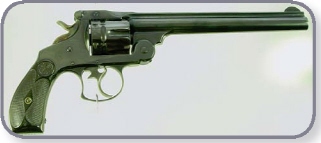
Designates an antique gun in much better condition than Antique Excellent, but not quite As New. This gun shows slight muzzle and high edge wear, with probably 98-99% original bright blue remaining.
Excellent
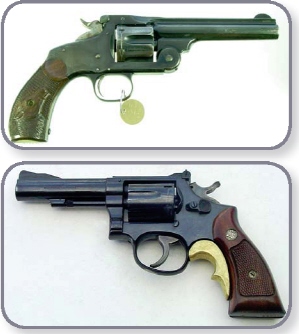
Antique Excellent (left) can have as little as 80% original finish left, depending on age. This one may rate 90-95% with noticeable wear at muzzle and sides of barrel, and on the cylinder. Altered grips would have to be disclosed in a fair description, since they deviate from the “Excellent” definition. Modern excellent will usually have 98% original finish for recent guns, such as this one showing a bit of muzzle wear.
Fine

Fine applies only to older and antique guns, and includes a wide range of original finish remaining. Here, the finish is distinctly worn on the barrel and thinning on the frame with the rear of the frame having lost the original finish to a plum patina. Possibly 50 - 60% original finish remains. In a complete fair description, the areas of fine spotting on the barrel and the scratches would be disclosed.
Very Good

An Antique Very Good gun may have just a bit of original finish remaining. Here the gun has gone mostly gray with light spotting and maybe 20% dulling blue remaining in protected areas. Later guns will need substantial amounts of original finish to rate Very Good. The upper right N frame shows heavy wear on the cylinder, but still might rate 60-70% overall, while the lower right K frame has a bit less wear for possibly an 85 - 90% overall rating.
Good

An Antique Good gun will usually have no original finish, as shown here. Modern Good can show fairly heavy finish wear, as with the Hand Ejector above.
Fair
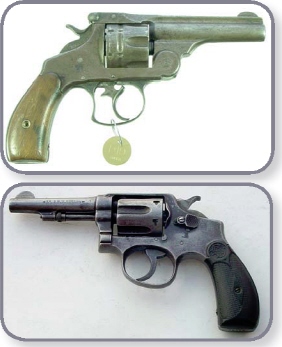
For either modern or antique, a Fair gun can be pretty rough, so long as it is more or less complete. Antique condition photos from Supica collection. Modern condition photos from ArmchairGunShow.com.
The above condition definitions were approached with some trepidation. To some, they may appear unnecessarily complex and something of a Frankenstein monster of stitched-together concepts.
Our intent is not to change or replace the NRA definitions, but to refine them as applied specifically to Smith & Wessons. We also hoped to incorporate a more specific application of the popular “percent of original finish” rating method into the familiar NRA style terminology, and address some factors that are important to value, but which are ignored by other systems.
Above all, we attempted to capture the underlying sense of these condition terms as they are most often used in the field by collectors and dealers when evaluating firearms.
To fully understand the intent of the above condition definitions, it is helpful to consider the well-accepted NRA condition definitions. NRA has established two different sets of condition standards for antique and modern firearms. They are as follows:
NRA Modern Firearms
Condition Ratings
NEW: Not previously sold at retail; in same condition as current factory production.
NEW, DISCONTINUED: Same as new, but discontinued model.
PERFECT: In new condition in every respect.
EXCELLENT: New condition; used but little; no noticeable marring of wood or metal; bluing perfect (except at muzzle or sharp edges).
VERY GOOD: In perfect working condition; no appreciable wear on working surfaces; no corrosion or pitting; only minor surface dents or scratches.
GOOD: In safe working condition; minor wear on working surfaces; no broken parts; no corrosion or pitting that will interfere with proper functioning.
FAIR: In safe working condition, but well worn; perhaps requiring replacement of minor parts or adjustments, which should be indicated in advertisement; no rust, but may have corrosion pits that do not render the article unsafe or inoperable.
Alternate NRA Modern
Definitions – Percent of Finish
There is another set of NRA Modern condition definitions that are seldom published and which concern themselves primarily with percentage of finish remaining. They are:
Mint: new in box, not previously sold at retail.
New/Perfect: 100% original finish with or without original packaging
Excellent: 95 - 99% original finish
Very Good: 80 - 94% original finish Good: 60 - 79% original finish Fair: 20 - 60% finish may or may not be original, but gun must function properly and fire.
Poor: Under 20% finish, functioning and firing not a factor.
NRA Antique Firearms
Condition Ratings
FACTORY NEW: All original parts; 100% original finish; in perfect condition in every respect, inside and out.
EXCELLENT: All original parts; over 80% original finish; sharp lettering, numerals, and design on metal and wood; unmarred wood; fine bore.
FINE: All original parts; over 30% original finish; sharp lettering, numerals, and design on metal and wood; minor marks in wood; good bore.
VERY GOOD: All original parts; zero to 30% original finish; original metal surfaces smooth with all edges sharp; clear lettering, numerals and design on metal; wood slightly scratched or bruised; bore disregarded for collector firearms.
GOOD: Some minor replacement parts; metal smoothly rusted or lightly pitted in places, cleaned, or reblued; principal lettering, numerals, and design on metal legible; wood refinished, scratched, bruised, or minor cracks repaired; in good working order.
FAIR: Some major parts replaced; minor replacement parts may be required; metal rusted, may be lightly pitted all over, vigorously cleaned, or reblued; rounded edges of metal and wood; principal lettering, numerals, and design on metal partly obliterated; wood scratched, bruised, cracked, or repaired when broken; in fair working order or can be easily repaired and placed in working order.
POOR: Major and minor parts replaced; major replacement parts required and extensive restoration needed; metal deeply pitted; principal lettering, numerals, and design obliterated; wood badly scratched, bruised, cracked, or broken; mechanically inoperative; generally undesirable as a collectors firearm.
As you can see, these NRA definitions are rather concise and elegant, and designed to apply to a wide range of firearms in a wide range of conditions. What we have tried to do is to focus them on S&W’s, particularly addressing the following concerns:
Disparity Between Antique and Modern Definitions
The widely differing NRA standards for antique and modern guns make a great deal of sense when you consider that they must cover both a seventeenth century flintlock and a 1995 production polymer framed semi-auto. However, they can cause a problem in S&Ws when the products span both sides of the modern/antique line.
While the NRA guidelines do not define “antique” and “modern,” under Federal law the cutoff date between modern and antique firearms is 1898 – those made in or before that year are antique, with more recent production being modern. Hence, if you take two top-break revolvers, both in 80% original finish condition, but one made in 1898 and the other in 1899, the antique gun would be rated excellent while the modern gun would be closer to good.
You will notice that in this book, we have tended to apply antique condition terminology (i.e., “Fine” condition listed, but no “NIB”) to tip-up and top-break revolvers, even though some top-breaks were produced as late as 1940. Likewise we’ve applied modern condition terminology (i.e., “NIB” condition listed, but no “Fine”) to Hand Ejectors even though some were produced as early as 1896. This was done primarily to avoid artificial breaks in condition ratings based on an arbitrary cutoff date.
Regardless of whether the values listed in this book include “Fine” (as with NRA Antique) or “NIB” (as with NRA Modern), the condition required to reach a certain level in this book will depend to a certain extent on the actual vintage of the gun and application of our sliding scale.
It seems to us that collectors and dealers evaluating an older gun tend, perhaps unconsciously, to apply their own internal mental version of this sliding scale concept, expecting more original finish on more recently produced guns to attain the same condition description.
Disparity Between Guns
Produced Decades Apart
In real life, the more recently the gun was produced, the better the condition it is likely to be found in. It would create an unrealistic picture of the marketplace to insist that an 1858 First First would have to have the same objective amount of condition to be considered Antique Excellent as an 1898 .32 HE 1st Model. The same rationale would apply to an 1899 New Departure compared to a Sigma under the modern ratings.
Disparity of Original Finish
Remaining within a Definition
This is probably most apparent in the NRA Antique Fine definition, which includes guns with 30% to 80% original finish. In practice, an antique gun with 80% original finish may bring a price double or more that of one with 30% original finish.
In our experience, collectors and dealers tend to make unconscious mental adjustments in their rating and pricing to adapt to these disparities. To reflect this we have tried to build a sliding scale of condition relative to era into the book’s definitions, without going outside of the accepted ranges of the NRA definitions. We have also attempted to account for the fact that, all other things being equal, a collector will want to see a slightly greater percentage of original finish remaining on a nickel gun that he will on a blued gun to assign similar values to each.
The Real World of Modified and Refinished Guns
There is little allowance in the NRA definitions for otherwise high condition guns that have been refinished or modified during their period of use. Our experience is that these guns find ready buyers at higher prices than their strict NRA condition rating would warrant, so we have tried to include these in the scope of the book’s definitions. Particularly, factory refinished guns and Western era modified guns are of special interest to S&W collectors, as discussed earlier.
Percentages – Precision or Problem?
The “percentage” system of rating has increased greatly in popularity over the past couple of decades. This method describes the gun based on the percentage of original factory finish remaining. Advocates of this approach report that it offers a much more precise method of describing the condition of a gun than the NRA condition ratings, and is less susceptible to abuse or misunderstanding.
Using the percentage of original finish to describe a gun’s condition is indeed an excellent tool, and those seeking accuracy in describing a gun will often use it with good effect. However, it’s important to bear in mind some limitations of the percentage approach that prevent its universal application, or limit its effectiveness. These limitations include:
• Since it only considers original finish remaining, it cannot be applied to refinished guns.
• It cannot be easily applied to stainless steel guns or polymer components.
• Many, if not a majority, of antique guns are found with no original finish. The percentage system cannot be applied to these, and would not distinguish between a crisp desireable patina gun vs. a heavily abused amateur buffed & chrome re-plated beater.
• Percentage of finish description alone does not take into account altered or modified guns, again especially an important consideration in the antique field.
It is difficult to account for aging of finish. Nickel guns may turn “milky” or “frosty” with age. Is it still original finish? Likewise, bluing, or especially case colors, may dull with age or exposure to sunlight. Bluing also tend to turn “plum” as it is lost to age – a process whereby tiny brownish-purplish spot can be observed “coming up through” the bluing, often observable only with a strong light. It is very difficult to estimate a percentage of blue remaining when the plum patina begins to emerge evenly spread throughout the gun’s finish.
Percentage alone does not account for variations in the condition of the metal beyond coverage with original finish. An 80% blued gun with heavy pitting where the blue is gone will bring substantially less than an 80% gun where the metal remains crisp where the finish has worn. A nickel gun covered with tiny sub-hairline scratches that don’t actually penetrate the plating will be less desireable than the same gun with smooth bright nickel remaining.
From observation of the collecting market, it seems possible that some of the most sophisticated, condition-oriented collectors who are the strongest advocates of the percentage system may be unintentionally contributing to the denigration of its touted precision.
The case for percentage ratings leans strongly on the system being quantifiable and objective, with little room for subjective judgement errors. However, it appears that often collectors using the system may not actually be looking at the true “percentage remaining” of factory finish. This appears to be especially true among some of the most demanding, condition-conscious collectors who are interested primarily in guns with 97% or better original finish.
The rough diagram shown here illustrates a grid imposed on a drawing of a revolver. There are approximately 100 squares total on the metal surfaces of the gun. (The area covered by the grip panels is not counted – if it were, the squares would be larger.) Accordingly, each square could be considered very roughly 1% of metal finish coverage. This illustrates how much finish could actually be gone from a gun to receive a particular percentage rating – two squares missing would be a 98% gun, ten squares a 90% gun, etc.
Our observation is that some condition-oriented collectors would consider a revolver with a bit of muzzle wear, a cylinder drag line, and perhaps some wear on the sharp edges of the cylinder flutes to be a 98% gun. However, from the illustration, it would seem that such a gun could actually have far less than 2% of the original finish missing.
Certainly this is a simplistic illustration, with its own flaws. However it is submitted in hopes that it may encourage collectors to examine their condition rating assumptions and techniques.
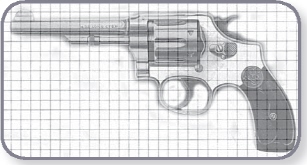
A Complete Condition Description
From the discussions above, it is readily apparent that either the NRA Condition description system or the Percentage of Finish system can at best be only a useful shorthand for a very general description of a gun’s condition. With more and more guns be sold sight unseen through the internet, auctions, and trade advertising publications, a complete description of a gun’s condition is important for transactions to be satisfactory for both buyers and sellers.
The following format may be helpful in devising or requesting a complete condition description of a gun being offered for sale or considered for purchase:
• Make, model & variation – usually including caliber and barrel length.
• General statement of NRA Condition – Excellent, Very Good, Good, etc. Factors that deviate from the accepted condition definitions should be explained in the rest of the description.
• Modifications – Note any replaced components, apparent repairs, alterations, or customization.
• Metal condition – Original finish, re-finish, or patina. Percentage of coverage of finish, broken down by the gun’s components if appropriate. Describe any scratches, pitting, or unusual blemishes. Note condition of contrasting finish on small parts if applicable.
• Markings – Crisp, legible, faint, or missing? Note missing or unusual markings. Note mismatched serial or assembly numbers.
• Mechanical condition – Working? Tight or loose? Note malfunctions or needed repairs.
• Bore condition. Note pitting or roughness.
• Stock condition, and whether numbered to the gun.
• Serial number. Some dealers and collectors show a reluctance to list a gun’s serial number, or sometimes substitute Xs for the last two to four digits of the number, such as “s/n 35XXX.” This seems less than helpful, and a smidge on the paranoid side to us, but hey, to each their own.
• Comments. You may wish to mention rarity, historical attribution, factory letter information, significance of the model, or other information that could interest a potential buyer.
Hypothetical example – Smith & Wesson .44 Hand Ejector, 1st Model, “Triple-lock” Target. .44 Special, 7.5" barrel. NRA Antique Fine condition. Frame and cylinder 80% original blue, with grip backstrap about turned gray, barrel 60%, 2" scratch on sideplate, small area of light pitting on the front of the cylinder, case color on hammer and trigger faded to gray. Good markings, matching numbers, including base of rear sight, except for unnumbered grips. Working but cylinder lock-up is a bit loose. Areas of light roughness in generally strong bore. Correct type medallion diamond grips fit well, but may be replaced from another gun, small chip from left heel, otherwise sound slightly worn condition with minor usage dings. Serial number ________. Factory letter shows shipped to Acme Gun Shop, Anytown U.S.A., on 12/25/1904, as a blue gun with target sights and a 7.5" barrel. This model was S&W’s first large frame swing out cylinder revolver, in a scarce target model configuration.
RESOURCES AND BIBLIOGRAPHY
S&W Factory Records
S&W collectors are very fortunate to be able to access original factory records on many individual Smith & Wesson firearms. This should be the starting place for researching special features on a gun or special history attributed to a gun. It will also often be the most dependable and definitive information available on a specific gun.
Through the foresight and generosity of the Smith & Wesson company and the Factory Historian Roy Jinks, the factory records and gun collection are being donated to the Connecticut Valley Historical Museum in Springfield, Massachusetts where they are being professionally archived, preserved, and indexed, with funding provided in part by the S&W Collectors Association (SWCA).
Factory Letters
Meanwhile, a factory letter on a specific gun is available from S&W for a research fee of $30. When requesting a factory letter, include as much information as possible on the gun, starting with the basics – model and serial number. Since even experienced collectors and dealers can make a mistake in identifying a model, it’s best to include all possible information including barrel address, patent dates, all other markings, caliber, barrel length, and finish. A photo, photocopy, or even pencil and paper tracing of the outline of the gun may be helpful. Be sure to specifically ask about any special features or history about which you have a question. It may give the researcher a clue that he would not know to follow otherwise.
The factory letter will generally include background information on the model in general, the date the specific gun was shipped, its destination, and any special or unusual features on the gun as shown in factory records. Sometimes a portion of this information will be unavailable. For example, records are missing for many of the earliest tip-ups, and it’s difficult to find accurate information on a New or Old Russian due to the numerous duplicate serial number ranges of the multiple Russian contracts.
Of course, the vast majority of S&Ws were shipped in standard configuration to large distributors. The chances of getting a hit (i.e., especially unusual or interesting information) on a standard configuration gun with no known history are slim, but it does happen. Even on a standard model, however, a factory letter can make an interesting part of a display for the piece.
Where factory letters are especially important are situations where a premium is being asked for special features or history. At a minimum, the letter should not flatly contradict the feature claimed. For example, a gun offered as a rare 2” barrel variation should not letter as shipped with a 4” barrel, and a gun attributed to an individual who died in 1922 should not letter as being shipped in 1925. At best, the letter may confirm the specific features or history attributed to the gun.
To order a factory letter, send the complete description and $30 to Smith & Wesson, Attn.: Mr. Roy Jinks, PO Box 2208, Springfield, MA 01102.
Smith & Wesson Collectors Association (SWCA)
Membership in SWCA is a worthwhile investment for any S&W enthusiast. The S&W Journal is worth the price of membership by itself. The association has an annual meeting held each year in a different part of the country. This members-only get-together includes a S&W-only gun show featuring both trade tables and competitively judged display exhibits, as well as lectures, social functions, awards, and a fundraising auction. Here you will see S&Ws that you will see nowhere else, and, most importantly, meet other enthusiasts and future friends. Membership applications are available from:
Smith & Wesson Collectors Association
c/o Michael G. Speers, Administrative Assistant
PO Box 357,
Larned, KS. 67550
Sponsorship by a current member or reference from a collectible gun dealer is required. If neither is available, the Administrative Assistant can arrange an informal phone interview of a prospective member by an officer or board member of the association. Current dues are $30 U.S., $40 international. Email to SWCA may be addressed to swca357@hotmail.com. An online application form may be found on the group website, theswca.org, specifically at http://www.theswca.org/swcaforum/New%20Member%20Application1.doc.
National Rifle Association
The NRA is far and away the most effective advocate protecting your endangered right to own firearms. Any collector who is not a member is simply not pulling his or her own weight. Not every collector agrees with every position that the NRA takes. This is fine, and appropriate; work to redress your concern within the organization. Meanwhile, present a united front protecting gun owners rights.
Contact the NRA at: NRA, 11250 Waples Mill Rd., Fairfax, VA 22030. Dues are $35 annually, $85 for three years, $125 for five years, with the prestigious life membership available for $750 ($375 for individuals over the age of 65 or disabled veterans) on a lump sum or installment plan basis. Their telephone number is 800-672-3888.
Springfield Research Service
(SRS)
They will research specific military-issued handguns for a fee. Charles Pate, SRS, P.O. Box 4181, Silver Spring, MD, 20904.
Books
Most serious collectors will want to start their S&W libraries with the books by Jinks and Neal & Jinks, along with the reprint volumes of the Journal of the SWCA. Recent years have seen more books published on S&W than had been available in the past.
The following books focus specifically on Smith &Wesson:
Smith & Wesson, 1857-1945 by Robert Neal and Roy Jinks. Out of print, this 434-page large format book is the bible of S&W collecting. Well-illustrated, it lists all Smith &Wesson guns by caliber through the end of WWII. It also includes invaluable information on experimental models, factory engraving, catalogs, and patents. Originally published in 1966 by A. S. Barnes & Co., it was revised and expanded in 1975. These original editions tend to retail in the $150 to $250 range. The Revised Edition was reprinted in 1996 by R&R Books. You will find it referenced in this book as “Neal & Jinks.”
The History of Smith & Wesson by Roy G. Jinks. Still in print, this concise and readable reference by the S&W factory historian is indispensable to anyone interested in these guns and their history. Well-illustrated, it covers all S&W guns from the beginnings of the firm through 1975, along with the history of the company and related topics. A must for serious and casual collectors. You will find it referenced in this book as “Jinks” or “the Jinks book.” 290 pages, about $28. Beinfield Publishing Co., Los Angeles.
S&W Collectors Association 25th Anniversary Journal reprints the first early years of The S&W Journal, official publication of the S&W Collectors Association. At present, three volumes have been published - Book 1 reprints Journals from 1970 through 1979, Book 2 contains 1980 through 1984, and Book 3 1985 to 1989. These contain important and detailed information found nowhere else, with an index. . Price $20 each, to members. You will find it referenced in this book as “SWCA Journal, Book 1 (or 2 or 3).”
Smith & Wesson Sixguns of the Old West by David Chicoine, 2004, published by Andrew Mowbray, Inc. This comprehensive book provides in depth coverage of the Model Three large frame top-break Smith & Wessons of the 1870s through turn of the century. It is unique in that it not only covers history and identification of the various models, but also includes extensive information on gunsmithing & shooting; including replicas.
The S&W American Model in US and Foreign Service by Charles Pate, not published as of this writing, but should be available by the time you read this. This should be an extremely well researched and written book on the American and 1st Model Russian revolvers.
Smith & Wesson Revolvers: The Pioneer Single Action Models by J. E. Parsons. Out of print, 227 pages, some illustrations, published in 1957 by William Morrow & Company, New York. Fascinating and authoritative account of the early S&W revolvers, especially in relationship to the American West. An extensive appendix is dedicated to reprinting the correspondence between Col. Schofield and S&W. Usually sells for around $50. Individuals interested in this era may also want to check out another book by the same author, The Peacemaker and its Rivals, which concerns primarily the Colt Single Action Army, but has a chapter dedicated to S&W products of the era and interesting reports of the army ordnance trials.
Smith & Wesson Handguns by R. C. McHenry and W. F. Roper, originally published in 1945 by Standard Publications, Inc. This book was the first to try to sort out S&Ws for collectors. Still interesting, although some of the material has been corrected over the past half century. Recently reprinted, original copies sell as collectibles for around $60.
Smith & Wesson - The Story of the Revolver by Martin Rywell, published 1953 by Pioneer Press, is another early work outlining the history of the firm and details of production of the various revolvers. About 140 pages, includes 40 pages of photos in the back.
The Knives of Smith & Wesson by C.E. Rinke, illustrates many standard models as well as prototypes and one-of-a-kind S&W knives.
America’s Right Arm – The Smith & Wesson Military and Police Revolver by John Henwood, published in 1997 by the author, 296 pages, photo illustrated, includes an extensive study of the quintessential S&W revolvers – the Military &Police Models – along with discussion of forerunners, related models, ammunition, and other related topics. Recently available through the NRA National Firearms Museum Store in Fairfax, VA, for $40.
Twelve Revolvers by Roy Jinks is a hardcover booklet originally printed to accompany the “Twelve Revolvers” commemorative series from Ellett Brothers. There are both standard & slip-cased Deluxe editions published. Of special interest are the lovely full color reproductions of advertising illustrations first commissioned by S&W in the early 1900’s.
Artistry in Arms by Roy Jinks covers the museum exhibit of the same name which included some of the most significant prototypes and beautifully engraved S&Ws extant, and toured international museums 1991-1995.
The S&W Revolver – a Shop Manual by Jerry Kuhnhausen. A well-regarded guide to S&W revolver repair and mechanical function.
History of Smith & Wesson Firearms by Dean Boorman. More of a coffee table book than a reference. Some interesting pictures and historical narrative, and one of the few S&W books prior to this one with color illustrations; contains some factual errors.
Gun Digest Book of Smith & Wesson by Patrick Sweeny.Primary focus on current production models with emphasis on selecting and shooting; similar material to that found in newsstand gun magazines.
Smith & Wesson Autos by Duncan Long. Primarily a user’s and shooter’s guide. Some factual errors reported.
Le Smith & Wesson No. 3 by J.-P. Bastie & D. Casanova, is a slim 110-page photo-illustrated paperback published in French only that may be of interest to collectors of old large frame top-breaks (especially those who can read the language).
Various Auction Catalogs
When an auction house prepares an illustrated catalog of a major S&W collection for sale, it can also serve as a good reference, especially for unusual or one of a kind guns. Back issues, with prices realized, can often be ordered from the auction houses. Some major S&W collections, auctioned with good catalogs in recent years, include the following:
Little John’s Antique Arms, Orange, CA. “Arms & Art of the Great American West,” Feb. 23, 1992. Includes some exceptional early S&Ws, as do many other Little John’s catalogs.
Butterfield & Butterfield, San Francisco. Volume A54, Sale 6464, July 23 and 24, 1996, S&W Factory Museum collection. Some unique & rare pieces. Also, Butterfield’s Sale 7248A, Feb. 27, 2001, featured the John Otteman Collection of S&W No. 2 Army Revolvers, with tables & information by Ronald Curtis.
James D. Julia, Inc., Fairfield, ME. March 10 and 11, 2003. Featured a large S&W collection. There are also a couple of truly exceptional pieces in their March 13, 2006, catalog.
Old Town Station, Ltd., Lenexa, KS. Dispatch #39 & 40, Oct. 26 and 27, 2003. Featured a major S&W collector’s estate.
Amoskeag Auction Co., Inc., Manchester, NH. Auction No. 49, Sept. 24, 2005. The Gary Garbrecht Collection of fine Smith & Wessons, including the Columbian Exhibition guns.
Rock Island Auction, Moline, IL. December 2005 Premiere Firearms Auction featured a number of nice S&Ws. There were also several hundred S&Ws in the beginning of their April 29, 2006, auction. As possibly the largest volume gun-specialty auction house, many Rock Island catalogs will include a number of S&Ws.
Kull & Supica, Topeka, KS. Dispatches #50, April 2006, and #52, Fall 2006; each features lifetime collections of S&W collectors.
Other Books
While not focused exclusively on S&Ws, the following books contain material of special interest to Smith and Wesson enthusiasts:
U.S. Handguns of World War II - The Secondary Pistols and Revolvers by Charles W. Pate (1998, Andrew Mowbray Inc., Publishers) is an exceptional work on the indicated topic, with material of special interest for S&W collectors on Victory and 1917 Models.
Evolution of the Winchester by R. Bruce McDowell (Armory Press 1985) contains in-depth information on the Volcanic lever action firearms of the first S&W partnership.
Steel Canvas by R. L. Wilson, Firearms Engraving As Decorative Art by Frederic A. Harris, and L. D. Nimschke, Firearms Engraver by R. L. Wilson are all helpful works on firearms engraving.
1840-1940 - Cien Anos de Pistolas y Revolveres Espanoles by Juan Luis Calvo & Eduardo Jimenez Sanchez-Malo is published in Spanish, is hard to find in the U.S., and has no information on actual S&W revolvers. However, it does contain hard-to-find material on the little-explored field of unauthorized Spanish-made copies of S&W pattern revolvers.
Gunsmithing Guns of the Old West by David Chicoine, Krause Publishing. Chicoine is well-known for restoration and repair work on antique S&Ws, and this contains helpful information on the topic.
There are several small books from decades ago that provide insight into Smith & Wesson handguns and target shooting in earlier years. Burning Powder by Maj. Roy D. Jones and later by Lt. Col. Douglas B. Wesson was first published by the S&W company in 1921. It includes discussions of shooting technique, S&W handguns, and target shooting competition from the early 20th century. The Pistol and Revolver by A. L. A. Himmelwright was first published in 1904, and covers an even earlier era of target competition, back in a time when revolver matches were national sporting events of a stature comparable to football or baseball today. Pistol and Revolver Shooting from 1945 by Walter F. Roper in 1945 and especially Bullet Holes by D. B. Wesson in 1915 will also be of interest.
Magazines
The S&W Journal, published by the SWCA, again contains information found nowhere else. It is a necessity for the advanced collector and well worth the price of membership for any S&W enthusiast. The Journal tends to be the cutting edge of S&W research. Membership details noted above.
Gun Report (monthly, $29.95 subscription, PO Box 38, Aledo, IL 61231) and Man At Arms (bimonthly, $24 subscription, PO Box 460, Lincoln, RI 02865) are two professionally produced magazines for gun collectors in general that often run information on S&Ws. The latter had an issue devoted entirely to S&W, with an article on S&W rarities by David Burghoff and an issue in May 1988 with an article by Charles Pate on the Australian Colonial Police model.
American Rifleman, membership magazine of the NRA, 11250 Waples Mill Road, Fairfax, VA, often has articles of interest to S&W collectors.
Publications which list collectible S&Ws for sale include the following:
Shotgun News and Gun List are both tabloid size publications that include both classified & display ads of guns for sale, along with articles of interest to general collectors. Shotgun News, PO Box 669, Hastings, NE 68902, ShotgunNews.com online. Gun List, 700 E. State St., Iola, WI, 54945, GunList.net online.
Old Town Station Dispatch is a mail order catalog of collector guns for sale published by Jim Supica, photo illustrated. $35 subscription, PO Box 14040, Lenexa, KS, 66285.
David Carroll is a pre-eminent specialty dealer of fine S&W handguns & publishes a mail order listing. P.O. Box 312 , Clay, Alabama 35048 USA.
Doug Carlson publishes a photo-illustrated catalog of antique American handguns that usually has some very nice old west S&Ws; 6 issue subscription is $20, PO Box 71035, Des Moines, IA, 50325.
Dixie Gun Works publishes a catalog of antique guns for sale which usually includes S&Ws. P.O. Box 130, Union City, TN, 38281.
General Gun Magazines
There are a number of excellent newsstand gun magazines that publish information on S&W’s new and current production models, and, seemingly with more frequency lately, articles on out of production collectible and historic firearms. They include Guns & Ammo, Shooting Times, Guns, Gun World, Handguns, Combat Handguns, and American Handgunner, among others. Of special interest to individuals considering the purchase of a current production S&W may be Gun Tests (seldom found on newstands – POB 420234, Palm Coast, FL, 32142) – they refuse advertising from firearms manufacturers and exclusively feature head to head shooting tests of guns by different manufacturers, often including S&W. Magazines for Cowboy Action Shooters such as Shoot!, The Shootist, and Cowboy Chronicles will sometimes have articles of interest on Old West S&Ws.
Price Guides
There are a number of general firearms price guides on the market. While all are useful, the authors have found the following to be of special merit.
Standard Catalog of Firearms by Krause Publications, updated annually. Utilizes an “Excellent” through “Poor” condition rating system. The user should carefully note that their definitions of Antique condition ratings are very different than the standard NRA definitions and the definitions used in this book. Photo illustrated.
Blue Book of Gun Values by Steve Fjestad, updated annually. Utilizes the percentage condition rating system, based on percent of original finish remaining on the gun (10% through 100%).
Flaydermans Guide to Antique American Firearms and Their Values by Norman Flayderman (Krause Publications), updated every few years. Illustrated, contains background information, uses NRA condition rating system, limited to antique American guns, but quite authoritative in that field.
S&W Online
Official S&W Website – www.smith-wesson.com – includes current product information, news releases, history, logo clothing and products for sale.

Smith-WessonForum.com – This is a very active and cordial online forum for all things S&W, open to the public. It’s a favorite place to ask questions, share information, and just hang out, and is frequented by many knowledgeable S&W enthusiasts. Its moderator team is led by Mike Packwood. The group was very helpful in the final corrections, additions, and pricing for this book. Highly recommended.
SWCA Website – www.theswca.org – Home of the S&W Collector Association website. It includes info on how to join, and how to order a factory letter.
SWCA Official Members-Only Forum – Available to members of the S&W Collectors Association only, the official SWCAforum Yahoo group includes participation by Factory Historian Roy Jinks, who answers members’ questions in the forum, including a reasonable number of requests for shipping dates on specific guns. It includes a number of files of special interest to serious collectors. Moderated by Mike Speers.
Joe Miller’s S&W Online Group – This Yahoo group is open to members of SWCA only, and is moderated by Joe Miller. It includes helpful files on S&W products.
NRA’s National Firearms Museum – http://nrahq.org/ shooting/museum/visit.shtml – NRA is seeking to include more substantive information for gun collectors on its website.
Armchair Gun Show – www.armchairgunshow.com – Jim Supica’s Old Town Station website includes listings of S&Ws for sale as well as general information on older S&Ws. Sister site www.ArmsBid.com covers Jim’s live auctions, including photos and prices realized from past auctions with emphasis on S&Ws.
RegisteredMagnum.com – Website dedicated to the first Magnum, Geoff Moore webmaster.
Specialty dealer website – www.dcarroll.net – David Carroll’s site.
Old West Gunsmith – http://www.oldwestgunsmith.com – David Chicoine’s website includes info on this highly respected S&W specialist’s books, gunsmithing services, parts, and guns for sale.
Buy ‘n’ Sell Websites – GunsAmerica.com seems to be the most popular online “classified ad” type listing service. Gunbroker.com and AuctionArms.com appear to lead the pack for “online auction” format sales.
Corrections and Additions
We have tried our best to assure the accuracy and completeness of the information in this book. Where there was a question, we tried to err on the side of including too much information instead of too little. No doubt we have made some errors and included obscure variations while overlooking more significant material. There are probably a few prices listed that will bring more amusement than enlightenment to experienced collectors.
We welcome corrections, additions, and comments. Please include any documentation that might allow us to substantiate changes in future editions.
Richard Nahas – E-Mail JET53SW@aol.com
Jim Supica
Old Town Station, Ltd./PO Box 14040
Lenexa, KS, 66285/Phone 913-492-3000
Fax 913-492-3022 / E-mail Jim@ArmchairGunShow.com
Websites: ArmchairGunShow.com and ArmsBid.com